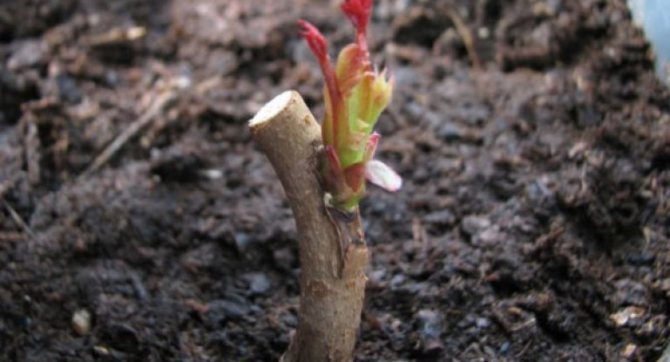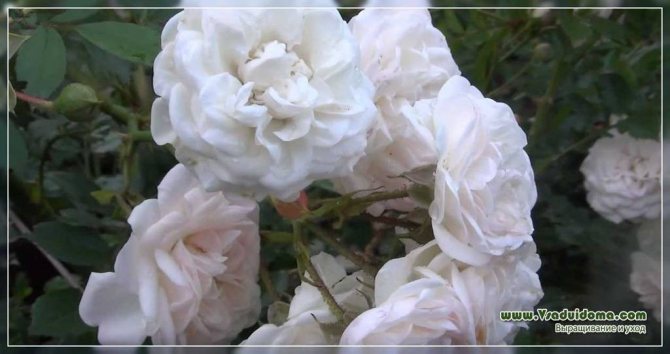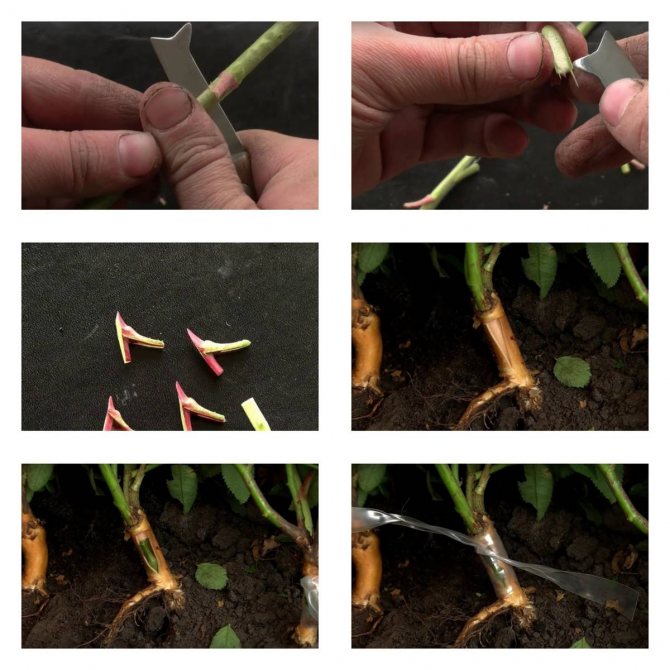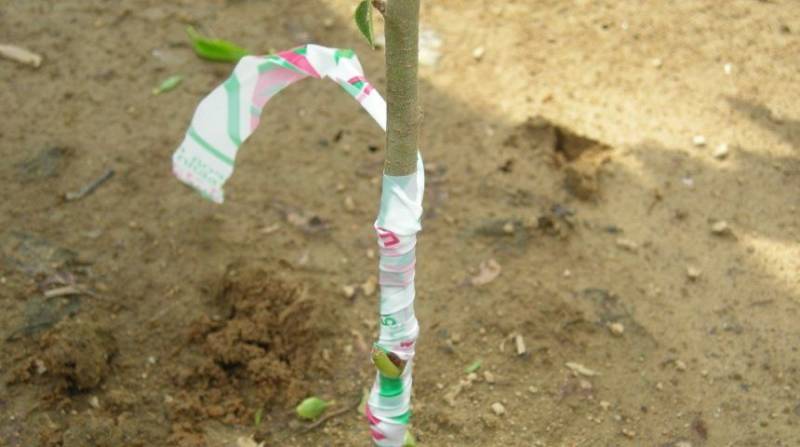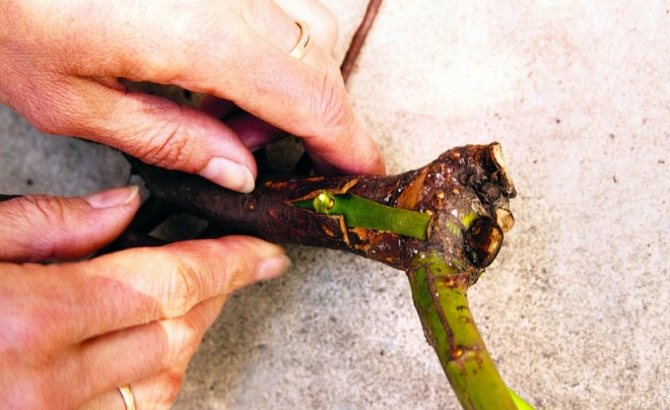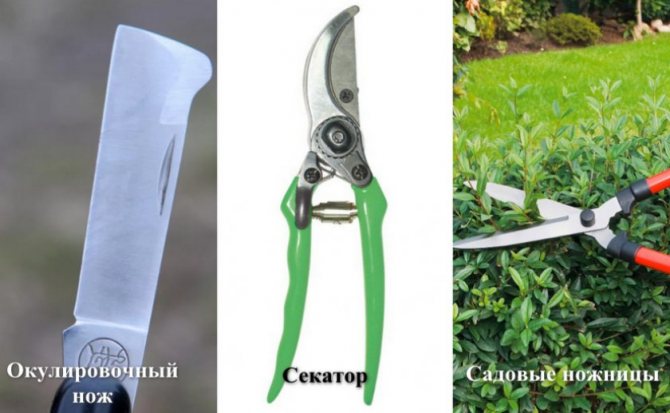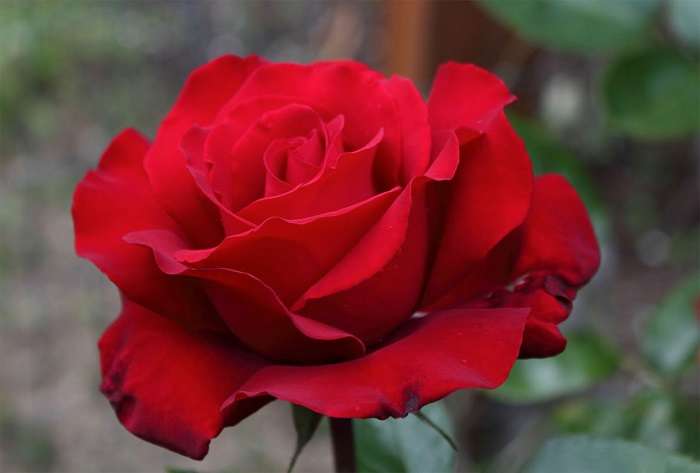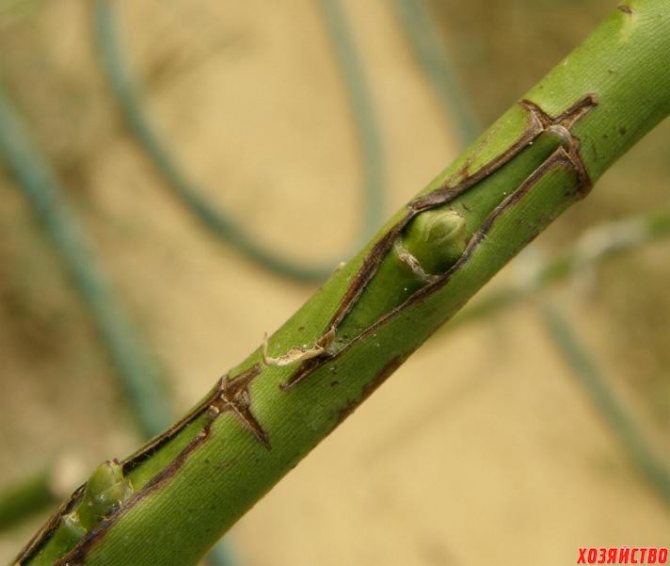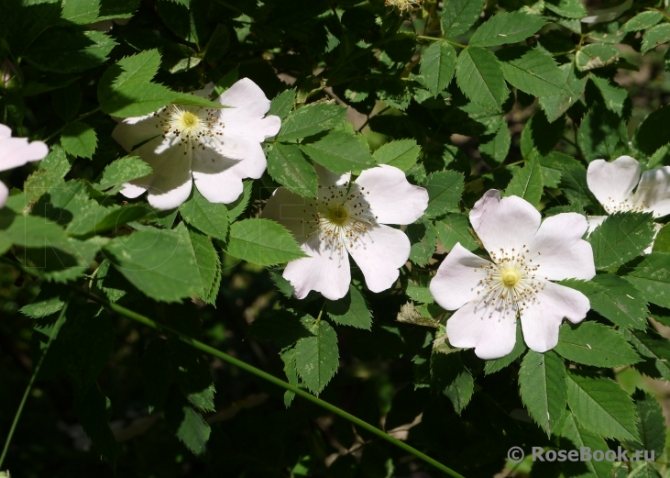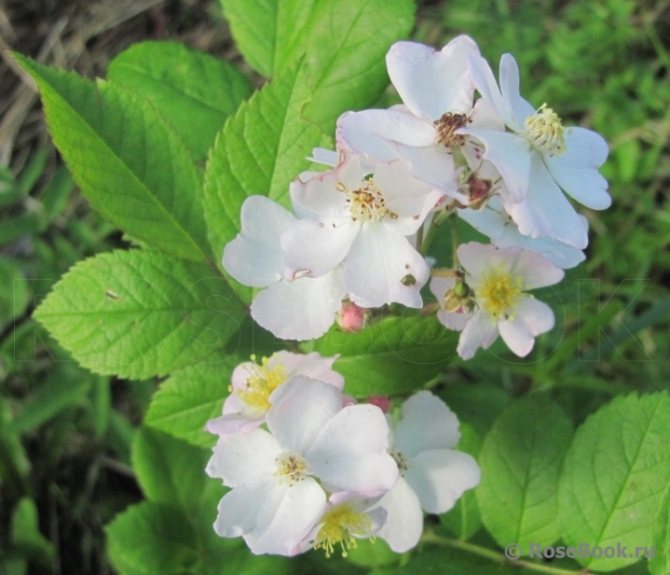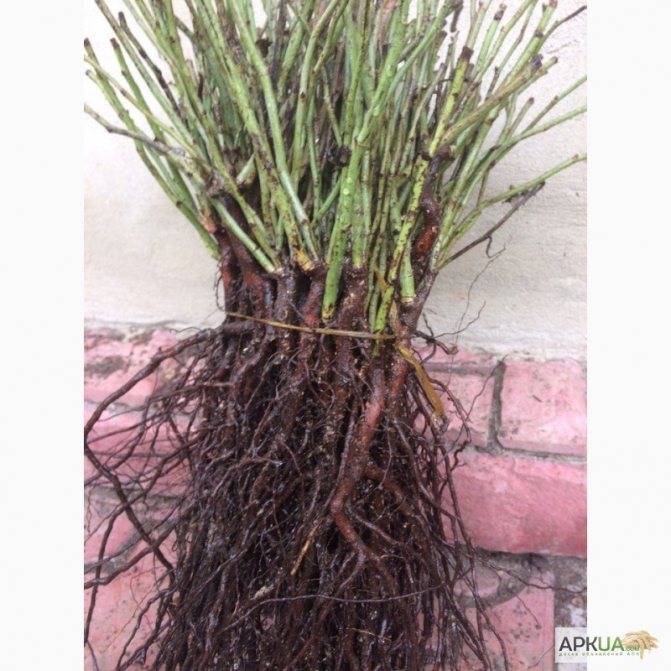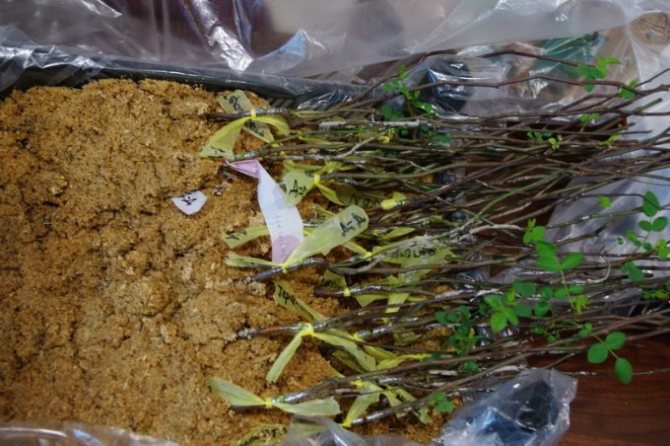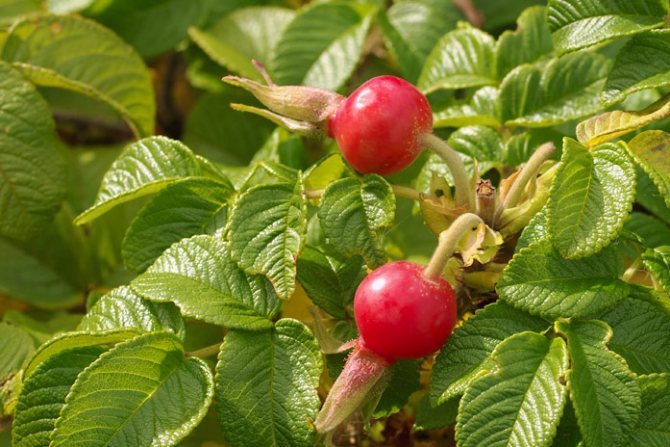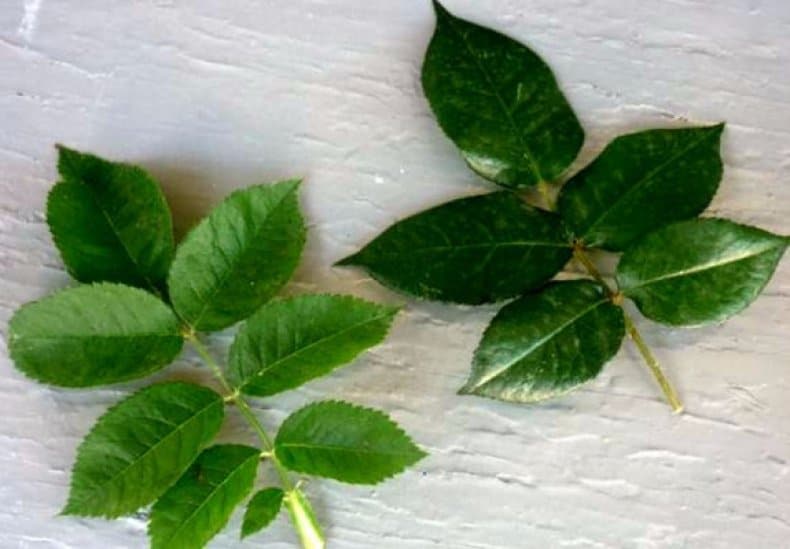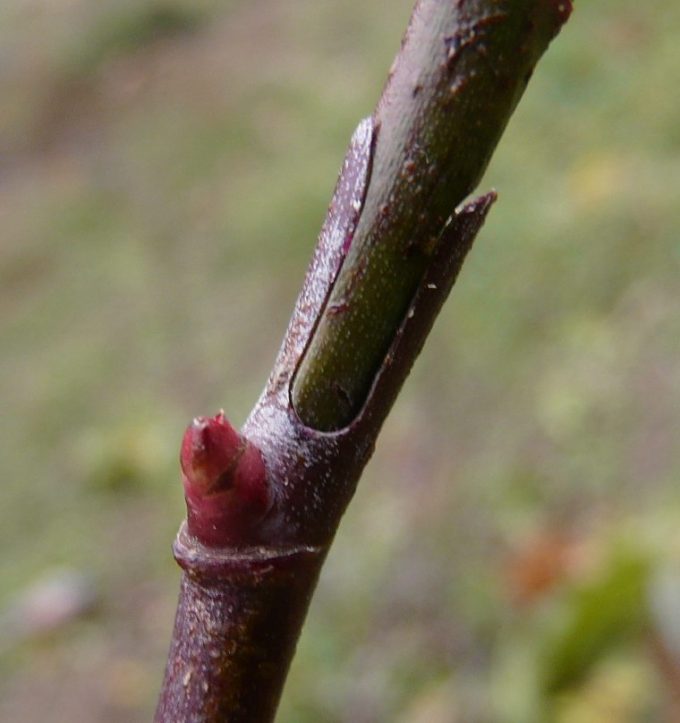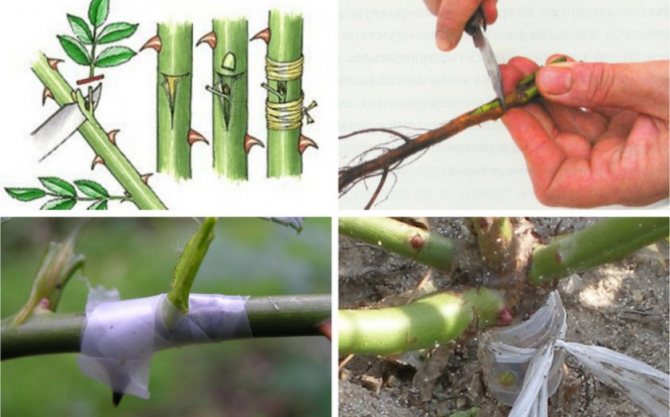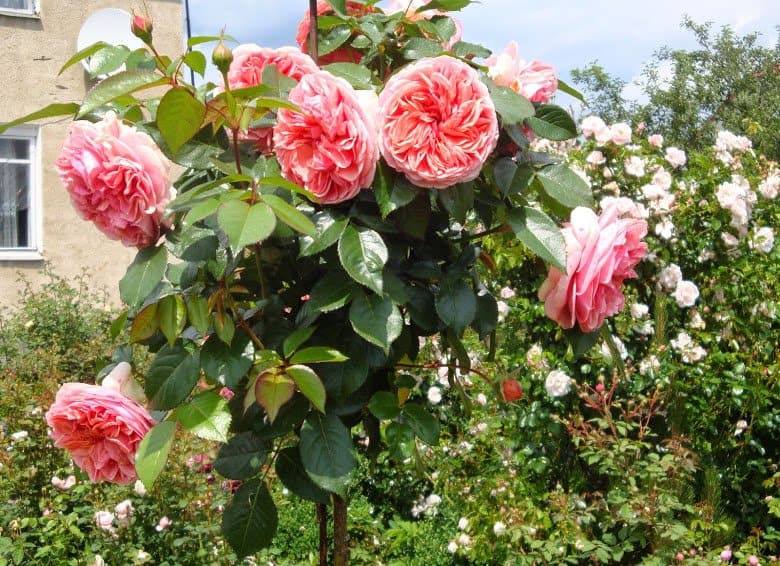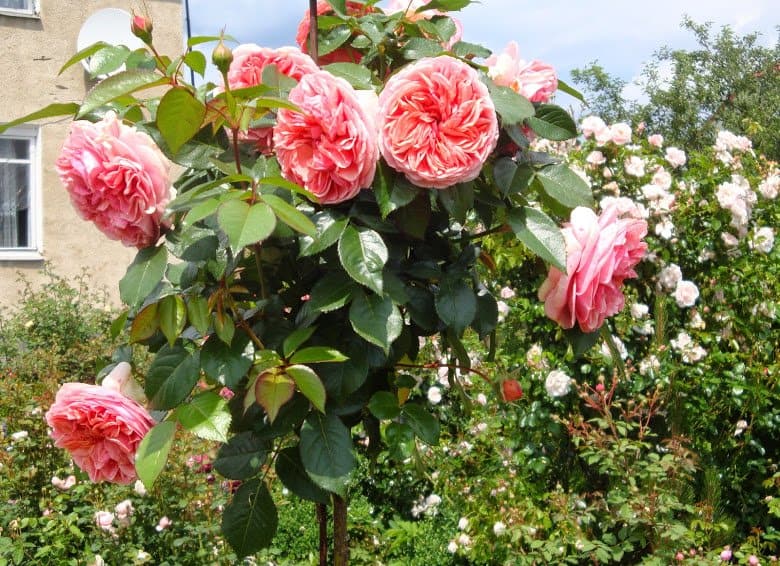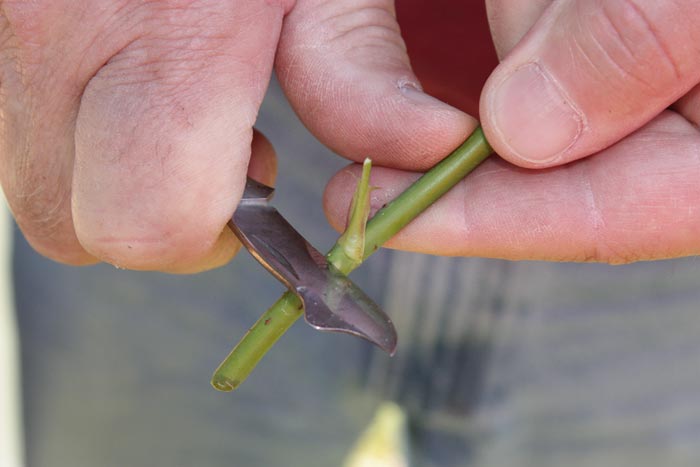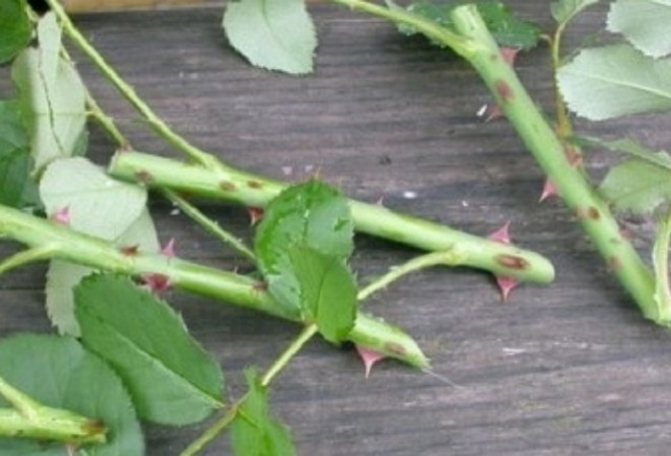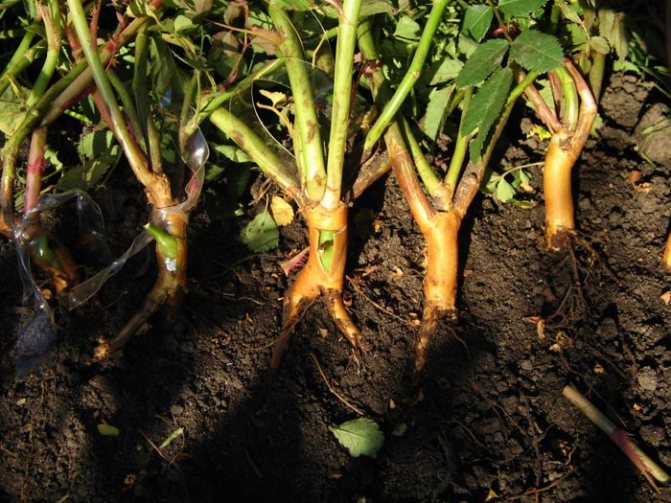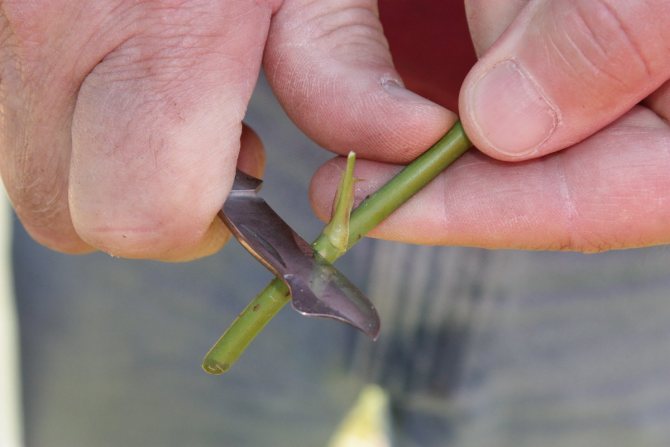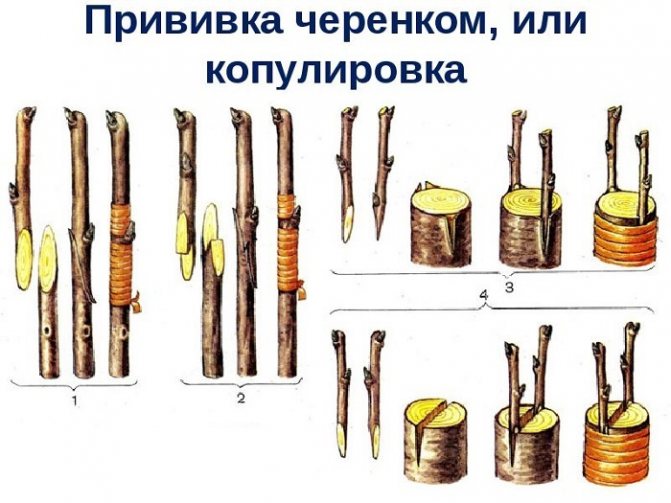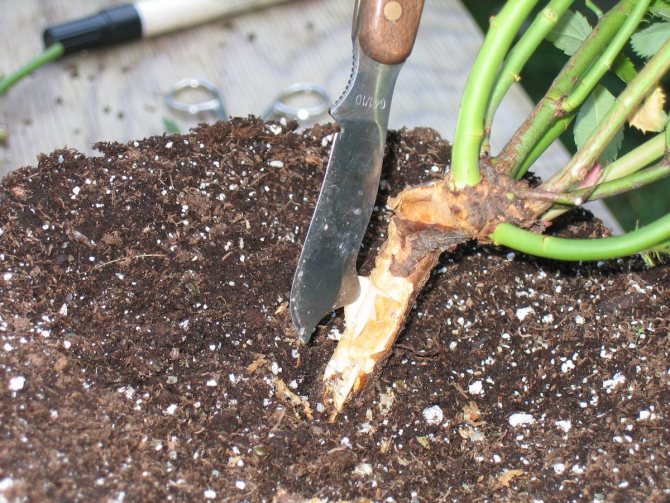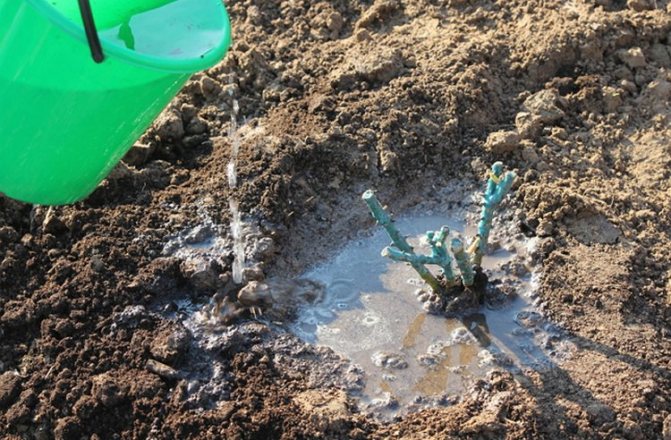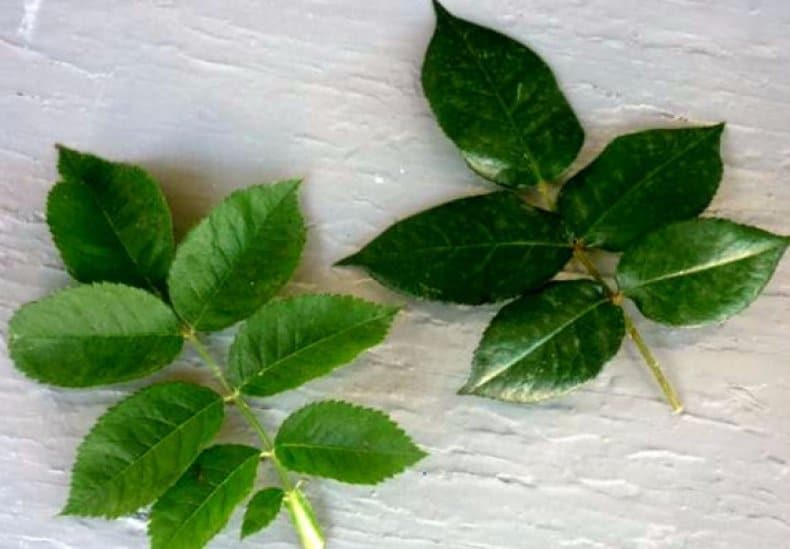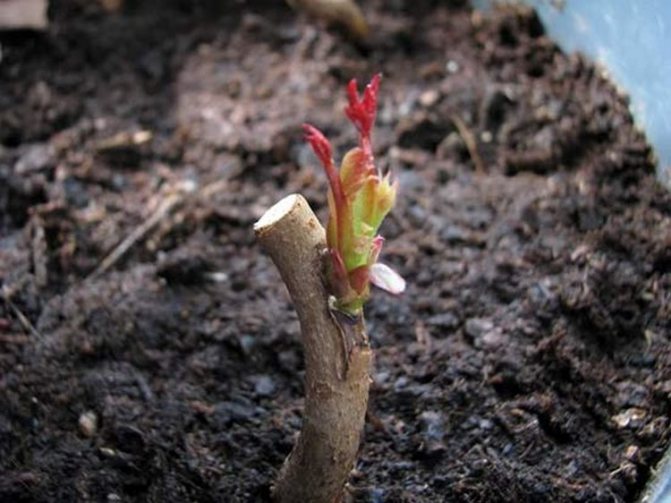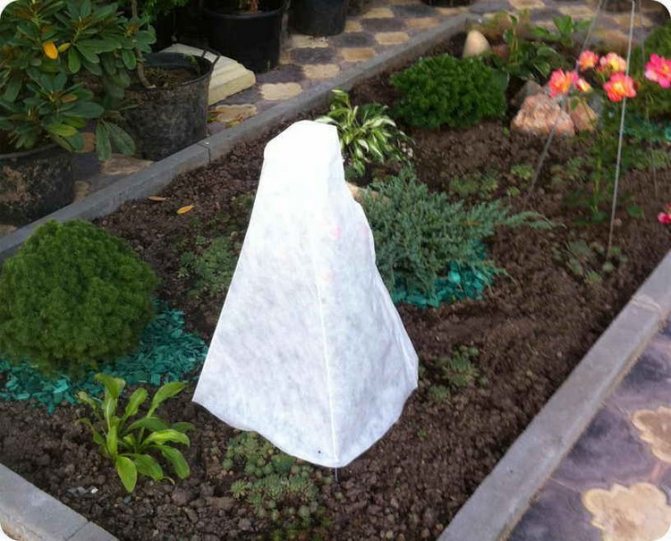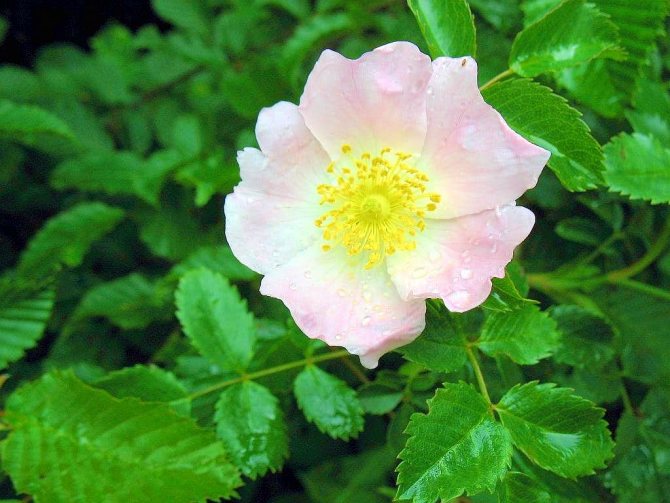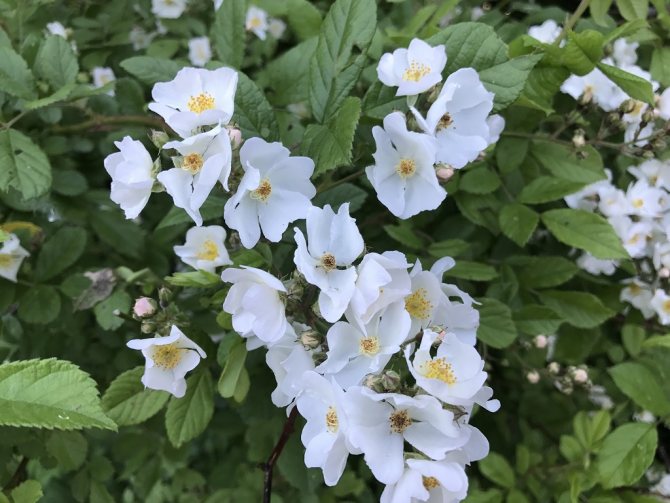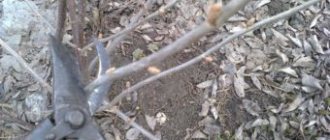A kidney transplant is a difficult and demanding operation in general. Even when it comes to rose buds. In this article I will tell you the whole truth about grafting roses using the budding method. You will understand why gardeners usually do not plant roses, but prefer to buy already grafted ones in the nursery.
Reproduction of roses by budding - everything you need to know for novice growers
METHODS FOR BREEDING ROSES
The main methods of propagation of roses, widely used in industrial and amateur floriculture, are cuttings and grafting.
Roses grown from rooted cuttings are called own-rooted. They have a number of advantages: they do not form wild growth, in the event of the death of the aerial part, new shoots grow from the root collar, and much less costs are required to grow self-rooted roses.
RARE PLANT SEEDS FOR YOUR GARDEN - FREE SHIPPING. PRICES ARE VERY LOW. THERE ARE REVIEWS

At the same time, the propagation of roses by cuttings has a number of disadvantages. Cuttings of many varieties do not take root well. A significant proportion of rooted cuttings die during the first wintering. Many varieties of self-rooted roses are significantly inferior to those grafted both in general development and in resistance to diseases and other unfavorable environmental factors. Therefore, such varieties are propagated only by grafting on vigorous rootstocks.
Reference by topic: Caring for roses before and after flowering
Preparation of stock and scion for grafting by budding
For beginners who do not have experience in overexposing rootstocks and storing cuttings, it is easier to learn how to do budding in the summer. To carry out such an inoculation, it is necessary to properly prepare the scion and stock:
| Stock preparation | Scion preparation |
|
|
REPRODUCTION OF ROSES BY SHEARS
Cutting is one of the simplest, most affordable and convenient methods of plant propagation. The most common method is June cuttings of roses with semi-lignified cuttings. The best timing for cuttings occurs at the end of June and continues until the end of July.
It is not recommended to cut cuttings during flowering, since at this moment they contain a minimum amount of auxin, a hormone that plays an important role in root formation. It is possible to increase the content of auxin in the cuttings using drugs that can stimulate the process of root formation: Heteroauxin, Kornevin, etc.
The rooting ability of cuttings largely depends on the biological characteristics of the rose variety and on the developmental phase of its shoots.
The condition of the plants from which the cuttings are cut is far from indifferent. It is desirable that roses grow in unshaded, open areas and are well developed. Shoots at the time of harvesting the cuttings should be extremely saturated with juices. Therefore, the harvesting of cuttings, if possible, is done in the early morning hours. Cuttings should be kept as turgor as possible prior to planting. To prevent cut shoots from losing moisture, they should be placed in water or wrapped in wet paper.
If, for any reason, the cuttings cannot be immediately planted for rooting, they must be stored in the refrigerator at 0-4 degrees Celsius.
Shoot buds in the leaf axils at the time of propagation should be dormant. Cuttings with germinating buds rarely take root: in them, spare plastic substances are directed to the formation of shoots, and not roots.
Errors when budding roses


After the sprouting of the eye, the stock is trimmed above the scion shoot and all competing shoots are removed.
Failures with budding roses are most often associated with the following errors of flower growers:
- Incorrect slicing.
The cut should be perfectly smooth, performed in one movement. The sharpness of the knife plays a key role here. The tool should cut the shoot, not saw. The second nuance is too short shields. The area of contact with the rootstock must be sufficient, otherwise the bud will simply dry out.
- Abandoning competing shoots.
All shoots coming from the rootstock areas located below the graft must be removed.
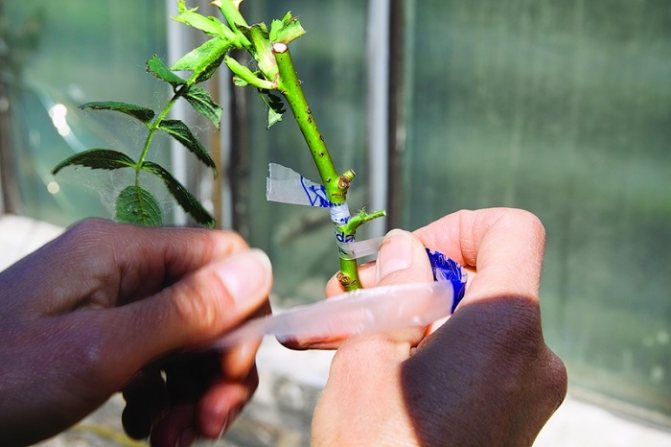

When budding on a shoot, the thickness and maturity of the stock is important: it should not be too thin
They take food on themselves and do not allow the eye to take root and germinate.
- Bad strapping.
A loose, loose binding does not provide a good fit between the scion and rootstock. As a result, no fusion occurs and the vaccine is rejected.
When carrying out budding, two rules must also be observed: work very quickly and observe the maximum sterility of the sections.
WILL THE ROSES FROM THE BOUQUET ROOT?
The question is often asked: "Is it possible to cut roses from gift bouquets?" The answer cannot be unambiguous. If you were presented with cut roses of domestic producers, then you can count on 50% success. If the product is of imported origin, the question arises about the duration of transportation and processing of it with drugs that prolong the preservation, which reduce root formation to zero.
In addition, imported cut products, as a rule, come from regions whose climatic conditions are far from similar to ours, and even in the case of a single success, a variety that has an amazing appearance may not meet your expectations (dull color, small flower and leaf size ).
How to plant a rose on a rosehip in summer or early autumn: video
The video shows how to prepare the stem for budding, how to correctly make a T-cut and separate the bark.
"Queens" and "princesses" of the garden, garden roses, do not leave anyone indifferent. They are adorable, glamorous and smell insanely delicious! Their cupped shape, rich shades make amateur gardeners think about grafting on a rose hip, because growing many rose bushes by themselves is a difficult task, and a rose hip bush is quite adapted to local lands and weather conditions. Everyone will find detailed instructions and even a video of the process here and understand that it is possible to do it yourself!
How to cut the cuttings
Cut the cuttings into two internodes long (with three leaves) or into one internode (with two leaves). The first type of cutting cuttings is applicable for difficult-to-root varieties and cuttings with short internodes.
Cut the cuttings with a very sharp tool. The cuts must be absolutely smooth.
The lower cut at the cutting is made oblique, at an angle of 45 degrees, directly under the bud, removing the leaf. The upper cut is straight - 0.5-1 cm above the kidney. The remaining leaves are pruned by one to two thirds to avoid excess moisture evaporation. Prepared cuttings can be treated with "Zircon" before planting, which will ensure the formation of a powerful root system. To do this, the cuttings are soaked for 12 hours, dropping them into a solution (1 ampoule of solution per 2 liters of water) by 1.5-3 cm.
Grafting a rose on a rosehip, or the concept of a scion and rootstock
Growing a rose bush on your own is a daunting task.The beauty is demanding on the composition of the soil - she loves nutritious soils full of humus, to the temperature regime - she does not tolerate frosts, to the length of daylight hours - she does not give rich flowering where there is little sun. And the rosehip bush is like weeds: it grows on all kinds of soils, feels great, pleases with abundant flowering of rose buds and a harvest of berries. That is why it is chosen as the basis on which the rose will be grafted. And the rosehip in this case is called the stock, and the rose is called the scion.
Requirements for stock and scion. Important features
As a stock, a rosehip bush is used at least 3 years old and one that has not been planted from the cuttings. Roses are grafted onto strong, healthy shoots of the mother bush, which are at least 10 mm in diameter. The bark on the rose hips should be smooth, uniform, without damage.
Roses grafted onto rose hips are more hardy and strong
The graft is chosen from cultivated varieties and, better, from local selection. This guarantees better plant survival, less susceptibility to diseases. For the scion, cuttings with a well-defined dormant bud are cut from the stem, the rest are pinched. All forces for the development of the scion should be focused on the growth of the stem, and not on the development of the buds.
Attention! Prepared cuttings of a rose with buds can be wrapped in a damp cloth and stored in the refrigerator - as a last resort. But no more than 7 days! The best option is fresh cuttings for grafting.
LANDING OF ROSE CHERENKOV
For mass cuttings, it is best to use boxes that are filled with nutritious soil by 7-8 cm, a layer of clean river sand 2-3 cm thick is poured over the ground, having previously washed it until the silty particles are completely removed. Well washed sand should not cause noticeable turbidity of the water when stirred. The sand prepared in this way is spilled with a solution of potassium permanganate.
Cuttings are planted obliquely at an angle of 45 degrees to a depth of 1.5-2 cm at a distance of 3-5 cm in a row and 5-8 cm between rows. After planting, the cuttings are watered abundantly with water and placed in a greenhouse, covering it with frames and shading it from the sun's rays.
During the rooting period, especially in the first one and a half to two weeks, the temperature, humidity of the soil and air in the greenhouse are of decisive importance. The stalk retains its viability only with a strictly balanced intake and evaporation of water. In sunny weather, cuttings are sprayed 4-5 times a day. On cloudy days, 1-2 sprays are enough.
After 10-12 days, a white influx (callus) appears at the ends of the cuttings, and after 15-30 days - the roots. After the roots appear, the number of sprays is reduced to 2-3 times a day and, opening the frames, they begin to accustom the rooted cuttings to fresh air. After 15-20 days, the frames are removed altogether.
Such rooted cuttings cannot yet be planted in the ground, since they may not overwinter. It is better to leave them in a room with low temperatures for the winter, and plant them for growing in the spring.
Maintenance consists in daily watering, which is carried out without lifting the glass cover. Rooted cuttings are planted in pots with a diameter of 9 cm, filled with a nutrient mixture consisting of two parts of sod land, one part of decomposed humus and one part of coarse-grained washed sand.
When there are few cuttings, you can root them under a glass cover (jar). If rooting is done in a room, then the flower pot is filled with washed sand. A stalk is planted in the sand and covered with a jar. Install a pot of cuttings on the windowsills of windows facing east or west. If there are no such windows, you can use the northern and southern ones, but in the latter case, the cuttings must be shaded on sunny days.
After planting, the cuttings are again covered with a glass jar, which is now removed during watering.A week after planting, coasters are placed under the cans to provide air access to the cuttings. Finally, the cap is removed when the kidneys begin to actively develop.
Another way of rooting cuttings under hoods is also possible. Drainage is made at the bottom of the pot, then a layer of nutrient soil is poured, in the center of which a hole is made with a diameter of 3 cm and a depth of 4-5 cm. Sterile sand is poured into the hole for planting a cutting. This method is convenient in that there is no need to transplant the cuttings after rooting.
All described methods require constant monitoring and care of the cuttings.
Reproduction of roses by cuttings: video
Part 1 (Autumn)
An easy way to grow roses from cuttings. Part 1-Autumn
Part 2 (Spring)
An easy way to grow roses from cuttings. Part 2 - Spring
How to plant a rose step by step in spring, summer
The period of active sap flow is the right time for grafting roses.
- In spring - this is the end of April, the first decade of May.
- In summer - the second half of July, the first decade of August.
It is during this period that the bark is easily separated from the wood, and this is 90% of the success of the operation.
For the stock, you can take a rosehip - a 2 year old plant. Its characteristics:
- good root system;
- barrel thickness 7-8 mm.
A week before the operation, the bush is abundantly watered and hilled. Watering speeds up the movement of the sap, after which the bark leaves the wood better.
Easier to master the most common way of grafting roses - budding. Budding is a peephole grafting. The recommended timing of vaccinations for the middle lane is July-August.
Cut the stalk from the uterine bush of a varietal rose on the day of vaccination. Choose a strong annual shoot with fully formed buds located in the leaf axils. Cut off the central part with 3-4 buds.
We clean the stalk of thorns. Cut the leaves, leaving the stalks. We choose the most developed kidney (eye). We will cut out the shield after we make a T-shaped cut on the rootstock.
To do this, we rake the earth from the neck, clean it with a piece of clean rags. We make a T-shaped incision with a grafting shear or an eyepiece knife. It is easier to master the technique of vaccination with a knife, it is clearer.
First, make a horizontal incision on the neck (1 cm), then a vertical one, leading the knife from the bottom up. When the knife reaches the horizontal cut, unscrew the bark.
Cut out a 2 cm scutellum with a well-developed bud, remove the wood. Insert the shield into the incision and press down firmly with the bark. Proceed with strapping. Begin to lay the straps on top.
The kidney should remain outside, so when tying it, you need to carefully walk around the top and bottom with tape. The end of the winding is fixed under the extreme turn located below the cut. After 2 weeks, if the operation was successful, the petiole will disappear.
In the spring, budding with a sprouting eye can be carried out if summer budding has failed. Use the same bush, place the T-shaped cut on the other side or at a different height.
Summer budding roses: video
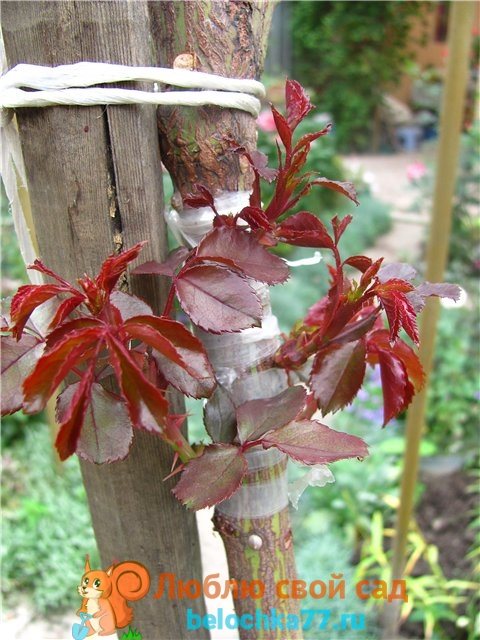

A rose on a stem is the dream of any gardener. It is real to grow it if you continue to master the technique of inoculation by the method of budding. To obtain a standard rose, you need a stock.
You can grow it from rosehip seeds collected in the fall, or find a suitable two-year-old bush in the forest or at your dacha. The bush should consist of healthy, non-branching shoots. It is necessary to leave one shoot the most straightforward, cut off all others at the level of the neck.
Before you dig up a seedling, you need to shorten all the branches growing on the future trunk. Their maximum length should not exceed 20 cm.
Store the stock in a cellar, get it out when warm days come, plant it on a section of the garden prepared for it. When planting, sprinkle the root collar and the lower section of the trunk with earth.
Sleeping eye budding is carried out from the end of July to the 20th of August. The principle of grafting on a rose in the summer is described above.The difference is in the location of the vaccination. When grafted into the root collar, a varietal rose bush is obtained. To obtain a standard rose, two T-shaped cuts are made at the height where they plan to form a crown:
- 80 cm from the ground - low crown;
- 1.2 m - a crown of medium height;
- 1.5 - high.
Before inoculation, cut out root growth and buds located below the site of inoculation. Inoculate 2 eyes, placing them on different sides of the trunk. The result of the operation is visible after 2 weeks. If all goes well, the petiole will disappear. A blackened, dried-up kidney is a sign of a failed vaccination.
A standard rose in the hands of a skilled grower becomes a real art object. Different varieties of roses are selected and budding is carried out in several stages. The result is a beautiful tree blooming all summer with flowers of different colors.
Grafting roses: video
Cuttings of varietal roses are used in the summer for grafting. Wild rose bushes are suitable as a stock. For scion, take semi-lignified shoots with good bark. Cut them into cuttings with 2 internodes. Leaves are not removed, but shortened to half their length. Inoculated for the bark.
To provide the grafted plant with constant moisture, it is covered with wet white paper and polyethylene. You can clean the mini-greenhouse after 14 days.
In spring, indoor roses can be planted with cuttings or buds. Cuttings are cut just before the operation. They choose a place for inoculation - a branch or a trunk. Methods for grafting indoor roses:
- budding;
- with a handle in a split;
- oblique grafting.
The cuts must be perfectly smooth. They are made with a sharp, clean instrument. Connect quickly. From the moment of cutting to the connection of the scion and rootstock, no more than 2 minutes should pass.
The budding method was described above. Inoculation into cleavage is carried out according to the following scheme:
- The upper part of the rootstock is cut flat (horizontally).
- In the center of the cut, a split is made to a depth of 2-3 cm.
- The graft (cutting of a varietal rose) is cut off nacosally (with a wedge).
- The graft is inserted into the cleft.
- The vaccination site is wrapped with tape.
- The grafted plant is placed in a warm room, watered moderately, but regularly.
- Provide diffused lighting.
To inoculate with an oblique cut, the diameters of the stems of the rootstock and the scion must be the same. The angles of the slices must also match. The graft and rootstock are combined, receiving a straight line, pulled together with a winding tape.
The grafted plants need to be looked after. In the fall, the shoots of a rose grafted into the root are cut off. Sprinkle the plant with earth and fallen leaves. In winter, they cover it with a thick layer of snow. In the spring, the mulch is removed.
A rose grafted into a stem:
- spud to a height of 20 cm;
- gently bent to the ground;
- equip the shelter using non-woven fabric;
- in winter they fall asleep with snow.
In the spring, they rake off the earth, remove the harness, retreat from the grafted eye 0.5 cm and cut the stock. The cut is covered with garden pitch. The eyes wake up after 3 weeks. The crown is formed by pinching the tops of the shoots growing from the buds.
A grafted rose in summer requires care, it includes the following works:
- watering;
- loosening;
- weed removal;
- feeding with complex fertilizers.
In the fall, a mature, formed bush can be transplanted.
Each climatic zone has its own dates for planting grafted roses. In central Russia, grafted roses are usually planted in the garden:
- in spring (from 04 to 20.05);
- in the fall (from 01.09 to 10.10).
Roses grafted into a stem are planted only in spring. A pit is prepared on the flower bed for planting 0.5 * 0.5 m.Prepare soil for backfilling:
- garden land (2 hours);
- humus (2 hours);
- sand (1 hour).
A small stake is driven into the center of the pit. Its upper end should not protrude beyond the inoculation site. An important point is backfilling the roots. There should be no voids. The soil should be close to the roots. The rose is poured abundantly with water. The stem is fixed to the peg with soft knitting. The support is needed so that the wind does not break it.
When planting a rose bush grafted into the root collar, the rule is observed: the bush is placed so that the root collar is covered with earth, and the graft does not protrude above its surface. The optimal location of the budding site is 2 cm below ground level. Extra growth is formed if the graft is above ground level. There is a slow growth of the rose with a strong deepening of the budding site.
Learning how to propagate roses by grafting is not easy. Practice and the necessary set of knowledge about varieties of roses, types of rootstocks, their optimal combinations will help.
Roses are recognized as the most beautiful flowers. However, in order to plant them in the garden, you need to try, since the process of growing such flowers is very difficult. Usually, to get a beautiful bush, roses are grafted onto a rose hip. For the success of this procedure, you need to know the intricacies of the selection of stock and scion.
PRESERVING YOUNG ROSES IN WINTER
Young rooted roses can be kept in non-freezing basements, after removing the herbaceous ends of the shoots and leaves, treating the roses with a fungicide. Roses are kept at a temperature of 0-3 degrees Celsius and a relative humidity of 65-75%, occasionally (as needed) watered. Successful wintering in basements is guaranteed only for well-developed strong bushes, when the plant has managed to accumulate a sufficient amount of organic matter in the tissues during the summer growing season. If the reserves of organic matter are insufficient, then the plant, having exhausted them for respiration, dies from exhaustion.
Successful wintering of young cuttings in the ground depends on the age of their root system. Young roots of cuttings are very tender, brittle, with a high water content and at the slightest damage they easily rot, decay spreads to the stem of the cuttings, it gradually turns black, and the plant dies.
If rooting took place at the beginning of July, and the roots had time to woody, became flexible, strong and acquired a brown color, then lowering the temperature to minus 2-3 degrees is no longer so destructive for the root system of young roses. In case of frostbite, their young tips are damaged, however, under favorable conditions, instead of the dead, the plant forms new adventitious roots. It was found that the root system of cuttings acquires frost resistance gradually, not earlier than 70-75 days after rooting.
Thus, for wintering in a greenhouse or open ground, plants that took root before July 1 and had time to develop well and get stronger before the onset of cold weather are suitable.
With the onset of night frosts (late September - early October), young roses are insulated by covering them with coniferous sawdust or dry sand mixed with peat in a ratio of 7: 3, so that the tops of the cuttings and leaves remain open. This shelter reliably protects the root system from short-term frosts and does not interfere with the growing season. After shelter, watering is stopped and, if possible, protect the rooted cuttings from precipitation. Under such a shelter, depending on the weather, roses are left until the end of October.
With the onset of stable cold weather and the termination of the growing season, additional warming is carried out with a second layer of sawdust or sand with peat, after removing the leaves and bending down long shoots, securing them with hooks and pressing them with slats. The total thickness of the two layers should be 8-10 cm.
In November, when persistent frosts reach 5-6 degrees, a third layer of sawdust or sand with peat 25 cm thick is poured (the total thickness of the covering layer is 35 cm).
Next, a frame made of metal rods or wooden shields (boxes) is installed over the roses, covered with a waterproof material (roofing felt or plastic wrap), on top of which spruce branches or a layer of dry foliage are placed.
During wintering, insulation should ensure that the temperature in the area of the cuttings is kept within the range from minus 2 to plus 2 degrees.
In addition, the insulation must be dry, since dampness is no less destructive for young roses than frost, therefore, the shelter must be reliably protected from the penetration of melt water during thaws.
With the onset of warm days (end of March), it is necessary to remove the snow from the shelters and gradually remove the insulation materials as the temperature rises. After the final removal of the cover, to protect the cuttings from morning frost, they must be kept under a light cover made of nonwoven material (spunbond) until mid-May.
Best of all, young roses of summer cuttings tolerate the first wintering in heated greenhouses or rooms, at daytime temperatures of 16-18, and at night-not higher than 12-14 degrees, where they continue the growing season. But under these wintering conditions, due to the lack of light for photosynthesis, roses need additional electric illumination from the end of October to March. In the absence of such a light source, the temperature during the winter months should not exceed 6 degrees Celsius.
At the end of May, after preliminary hardening, roses can be planted in a permanent place.
Why are the kidneys not engrafted?
Failures in budding roses happen from lack of experience, and also from the vagaries of the weather.
Attention! In nurseries of the middle lane, roses are always grafted in greenhouse conditions and only then young grafted plants are gradually accustomed to winter.
Rose growers who like to experiment with different rose hips and different varieties of roses know that finding a successful stock for a particular variety takes decades. I chose the wrong rosehip - all efforts were in vain.
Professionals use proven scion / rootstock combinations.
I have already written about the instrument and its purity. Everything must be clean and fast, otherwise it will crash.
The fun part: choosing the right date!
By the way! In theory, you can plant a rose all year round.
In winter, roses are planted by professionals and mainly in the southern latitudes. I did not try.
In the spring, it is easy to vaccinate, and the result - after two to three weeks - is obvious. However, if the spring is cold or rainy, the experiment will fail. In the summer, budding can be planned before the second wave of flowering. In the suburbs, this is mid-July - early August. Again, a lot depends on the weather.
In the fall, it is more difficult to vaccinate, you have to guess the time three weeks before frost. After grafting, immediately spud the plant high and with the onset of stable frosts, without cutting the rose hips, cover for the winter.
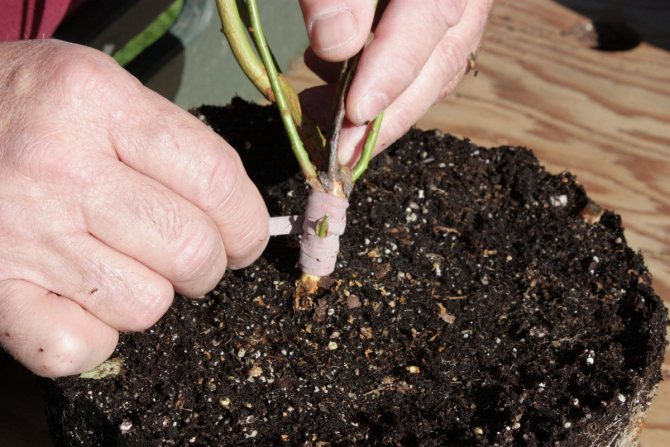

It is necessary to fix the grafted bud very tightly when budding a rose.
REPRODUCTION OF ROSES BY VACCINATION
The main method of propagation of roses is budding, or grafting of cultivars on a stock specially grown for this purpose. The quality of the grafted rose largely depends on the rosehip rootstock. You can graft on almost any wild species, but they are not equivalent as a rootstock - some species may exhibit such properties as fragility, poor winter hardiness, abundance of wild growth, superficial root system, etc.
In our climatic zone, the almost ubiquitous canina rose, or common wild rose, is widely used as a rootstock. This rootstock has good winter hardiness, a powerful branched root system, resistance to pests and diseases, has a fast growth, has an even and smooth root collar with easily peeling bark, durability, and has good compatibility with most varieties.
The roses stored in this way in mid-March must be transplanted into larger pots without destroying the coma, at the end of March and mid-April, with an interval of 15 days, make two top dressings with sodium humate.
Inoculation by cuttings
This method is used less frequently than budding. The time of its holding is mainly winter (on the table) or spring.Grafting methods: simple / improved copulation, grafting in the bark and in the cutout.
Tips and Secrets for Successful Vaccinations
- In summer, only dormant kidneys need to be vaccinated. They are taken from the scion plant after flowering.
- Requirements for scion shoots: at least 7 mm in diameter (more is better); they should not bend, which is a sign of maturity (immature ones simply do not take root);
- The scion cuttings must be kept in a damp cloth; it must not be allowed to dry out.
- Rootstock requirements:
- a young bush, which is 2-3 years old;
- the bark separates on it without problems;
- the bush must be grown in the same climatic zone where the rose will grow (it must be resistant to all external factors);
- you cannot get a stock from cuttings, only seedlings will do.
SEED REPRODUCTION OF ROOTS
Rootstock seeds can be harvested from naturally grown shrubs using the strongest specimens.
Seeds are collected in early autumn, when the outer shell of the fruit begins to stain. Sowing such seeds in autumn makes it possible to get some of the seedlings in the very first spring, but they must be immediately placed in the ground, preventing the shell from drying out.
If the seeds are harvested late, when sowing is no longer possible, they are stratified. To do this, the seeds are mixed in a box with damp sand (per one part of the seeds, three parts of disinfected sand), buried together with the box in the ground or put for the winter in a cold room with a temperature of 0-2 degrees and kept until next autumn. Duration of rosehip stratification is 12-18 months. By-
sowing is carried out in early October. The seeding depth is 4-5 cm. At this depth, the seeds will always be in moist soil, and the seedlings will form a long root collar, which will subsequently facilitate budding.
Rosehip shoots appear in early May. Two weeks after that, they start picking. The soil must be well cultivated and fertilized. When picking, the central seedling powder is pinched at a third of the length, which makes it possible to get plants with a strong, well-developed root system. Seedlings are planted at a distance of 10-12 cm.
During the summer, care for seedlings consists of watering, loosening, weeding and feeding, which is carried out with a solution of a complete mineral fertilizer with microelements at least once a month. Young plants respond very well to feeding with potassium permanganate (0.02 g per 1 liter of water). Plants become stronger and more resistant to fungal diseases.
Seedlings overwinter in ridges. In the second year, plant care remains the same, only the first feeding is done in May. It is very useful to mulch the plantings with rotted manure with a layer of 5-6 cm to enhance the growth of seedlings. In mid-July of the second year, most of the plants are ready for budding. For this purpose, wilds with a flat root collar, 4 mm thick or more, are used.
Rosehips with a root collar thicker than 7.5 mm are left for winter grafting with a cuttings. They dig it up in October and store it in a trench in cold basements.
When can you plant roses?
- In the spring. Unlike fruit trees, this grafting is not optimal for roses. It is carried out in cases where the plants grafted in the previous year did not survive the winter. It is more difficult to make it than summer because of the lack of a petiole. The main criteria for such an inoculation are intensive sap flow and the onset of positive temperatures.
- In summer. The optimal time for this event is July-August, when the sap flow of roses increases, which is necessary so that the grafting can first be carried out, and then take root. Most often, roses are grafted in the summer, because at this time all factors are combined: the plants are completely ready, and it is more convenient and more comfortable for people to carry out such an operation.
- In winter. Simple gardeners do winter grafting much less often.This is explained by the fact that it requires a number of works that do not need to be performed in the summer. In other words, winter vaccination is a very troublesome business. But it has its own meaning: the grafted plants will not be damaged by frost and will immediately grow after spring planting, forming a small bush until autumn. Winter grafting is carried out in closed warm rooms using pre-prepared rootstocks and scions. This vaccination can be done from the second half of December to February.
COLUMING TECHNIQUE
Budding in the ground in Belarus is carried out during the summer sap flow near the rootstocks (from mid-July to September).
Budding is carried out with a shield in the root collar of the rose hip, provided that the bark is easily separated from the wood and the diameter of the root collar is from 5 to 8 mm.
First of all, tea-hybrid roses, less prone to autumn sprouting of eyes, are inoculated, then varieties of roses of the floribunda group.
Two weeks before the start of summer budding, if the weather is dry, the rootstocks are well watered and spud with damp earth. This contributes to the saturation of the cambial layer with moisture and better separation of the bark. At the same time, shoots are removed, which may interfere with budding.
Cuttings intended for budding are harvested from the middle parts of faded shoots. The buds in the axils of the cuttings should be well developed, densely scaled and dormant. Non-flowering annual shoots are not suitable for budding - they contain a lot of water and their survival rate is very
small. The best time to cut cuttings is in the morning. Leaves are removed from the cut shoots with pruning shears, leaving a third of the petiole, so that in the future the cut shields have something to hold for budding. It is better to harvest cuttings on the day of budding work. If this is not possible, then the cut cuttings are stored in the refrigerator, wrapped in a damp film.
The technique of cutting the eye is of great importance for the survival rate of budding. Practice shows that it is preferable to inoculate a dog rose with an eye with a very thin layer of wood or without it at all. Therefore, the budding knife must be well sharpened, since the success of budding will directly depend on the cleanliness and smoothness of the cut. It is best to use a special budding knife with a rounded blade end and a flat bone on the handle to open the bark.
The procedure for budding is as follows. The root collar is undone, rubbed with a napkin until the bark is light-colored. Then, on one third of the circumference of the root collar, a transverse cut is made, then a longitudinal cut with a length of about 2 cm. By gently swinging the blade to the left and right, separate the bark and immediately press it against the wood. Before inserting the shield, the bark must adhere tightly to the wood, this is one of the main conditions for the success of budding, since the exposed cambium oxidizes very quickly, while changing color, which can adversely affect the grafting.
The scutellum is cut from the cutting with an upward movement, while capturing the thinnest possible layer of wood, on which the vascular bundle going to the bud should be clearly distinguishable, or the wood is carefully removed. The total length of the shield is about 2 cm, the lower part is 12 mm, the upper part is 8 mm, the kidney should be located at an equal distance from the lateral edges of the shield.
The shield is taken with the left hand for the remainder of the leaf petiole, and with the right, with the help of the bone of the budding knife, the bark is pushed apart. The flap is then inserted into the T-shaped incision. If necessary, the upper part of the flap should be trimmed (if it turned out to be larger than the T-shaped cut), press the flap tightly against the exposed wood. Then tie tightly from top to bottom with compress or insulating tape or tapes cut from plastic wrap, leaving only the eyelet free. Slide the end of the tape under the last turn and tighten.
The grafted dog rose is primed with moist earth so that the buds do not dry out.
After 15-20 days, you can check the survival rate of the eyes. If the bud is green and has increased in size, and the stalk falls off when pressed lightly, then the fusion was successful.
Advice
Budding can also be carried out in spring, during the period of the first intensive sap flow. It is called budding with a sprouting eye, because the grafted bud will soon germinate. It is often used to re-graft failed buddings from last year.
Vaccination
When grafting, do not touch the junction with your hands: the back of the shield and the inside of the pocket on the rootstock, disconnected from the wood. During operation, the shield is taken by the remaining leaf petiole.
Several stages can be distinguished:
- A few weeks before the grafting, the stock is covered with damp earth so that the skin better separates from the wood. Before budding it is undone and the root collar is wiped with a damp sponge.
- A T-shaped incision is made on the root collar. Then, with a knife, the edges of the cut are carefully separated from the wood and a shield prepared in advance is inserted under the bark. The direction of growth of the rootstock and the scion must match.
- The shield is strongly pressed against the bare wood and immediately tied with a film for grafting, while leaving the petiole free.
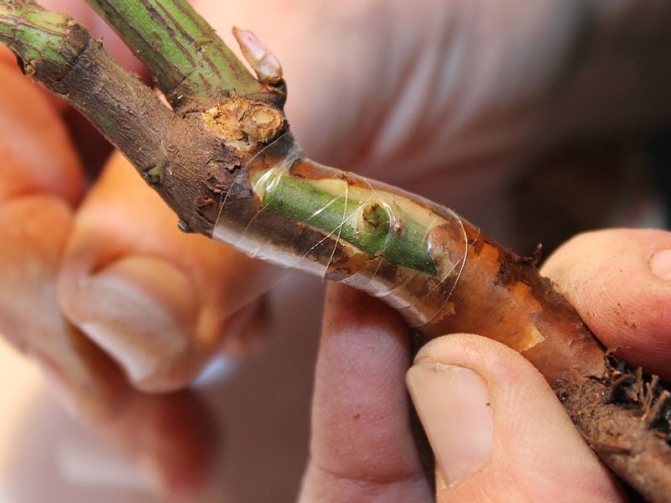

The film is wound from above, bypassing the peephole, I fix the end of the tape under the incision
- After grafting, the plant is covered with moist soil.
CARE FOR VOCULATED ROSES
With the onset of cold weather, in the first decade of November, the grafted bushes (oculants) must be dug up, transferred to a protected place and dug in. If this cannot be done, the dog rose is covered with earth to a height of 20-25 cm and a dry shelter is installed. At the end of April - beginning of May, the plants are carefully uncoated, the strapping is removed, cut to a "thorn" 0.5 cm above the grafted eye, the cut is covered with garden var and again slightly spud. The oculants in the trench are dug out, cut off on a "thorn" and planted in the nursery for growing.
After 2-3 weeks, the eyes of the eyepieces start to grow and break through from the soil to the surface. Sometimes, along with the main bud, the lateral, spare buds start to grow, so from one to three shoots can come to the surface at the same time. As soon as the shoot develops 3-4 leaves, it is necessary to pinch its apical part.
As a result of the pinching, after a while, the axillary buds start to grow, which give rise to the main skeletal branches of the grafted plant.
Further care of the eyepieces consists in watering, fertilizing, loosening the soil, in the fight against diseases and pests. During the entire growing season, it is necessary to cut out the wild growth that appears below the grafting site. By the end of July - beginning of August, a few buds can be left on strong shoots at the eyepieces. Flowering will slightly slow down the growth of the shoots and will facilitate their ripening. Normally developed oculants have three to five lateral shoots and well-ripened buds on the lower branching shoots. Rose bushes grown in this way are considered the best planting material.
Spring budding roses with a sprouting eye
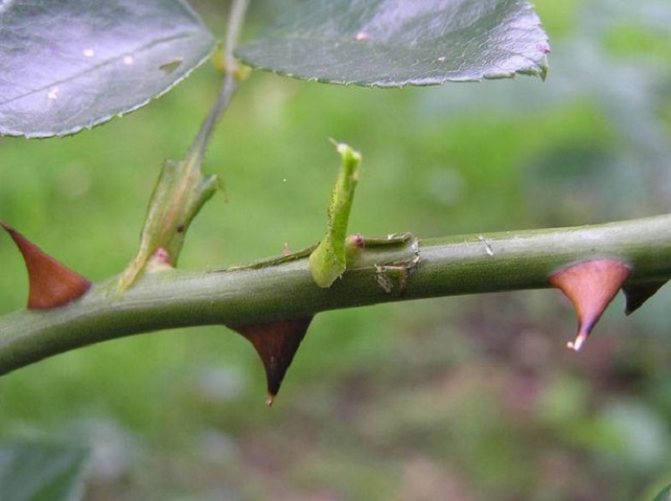

If the summer budding was carried out in the shoot, in the spring it is also cut off above the established bud.
For spring budding, already overwintered, mature buds, ready to germinate in the current season, are used. Therefore, the procedure is called "inoculation with a germinating eye". Its features are as follows:
- Cuttings for cutting eyes are taken in autumn or immediately before grafting from a well-wintered rose bush. If the cuttings were stored in the winter, it is important to inspect them and discard spoiled material.
- The stock is trimmed immediately after inoculation. Cutting height - one third of the length of the shoots.
- The indicator of the survival rate of the eye is its germination. If the spring peephole for some reason did not take root, in the summer you can do a re-grafting with a sleeping peephole.
The strapping on the spring budding is also left until the next spring. To avoid constrictions as the shoot grows, it is better to use an elastic material.
REPRODUCTION OF ROSES BY DIVISION OF THE BRUSH, ROOT SHEARS AND BRANCHES
The division of the bush is used for propagation of park roses. Each part of the plant should have a share of roots, one or more shoots.
Roses are propagated by root suckers, which easily sprout. It is cut off along with a part of the maternal root, for example, rose bush.
Small-flowered climbing and ground cover roses can be propagated by layering. For this, annual shoots are laid out in grooves and sprinkled with earth. Before laying the shoots in the grooves under the buds, the bark is incised, which stimulates the formation of roots. In the spring, the layers are dug up and planted for growing.
What should be the scion
The key to a successful vaccination is the correct graft. To get a scion from the mother bush, you need to cut off the most ripe branches. Further, the middle part is separated from them.
The graft should have a smooth and shiny bark and well-developed buds. Branches with such characteristics are very easy to graft.
Experienced gardeners advise using the budding method to increase the chances of better survival. This method will be discussed below. Its use guarantees 90-100% vaccination efficiency. Here, one kidney is taken, not a whole stalk.
FORMING BY YOURSELF
It takes three to four years to grow a standard stock of the proper height and quality from a rosehip seedling. To create strain 6a, one of the long shoots of the rosehip (1.5 m) is usually used, which is left on the bush, all the rest are cut out. A varietal rose is grafted into this stem at a certain height (1-1.5 m), from the shoots of which a flowering crown is formed in the future. In private floriculture, the easiest and fastest way is to prepare the stems among the perennial thickets of wild rose, choosing long young shoots extending from the base, the bark of which should be thin, not coarse. It is better to dig it in the fall and plant the stock stock in a permanent place in the form of a tapeworm (singly).
Grafting is carried out from mid-July, since sap flow in the upper part of the shoot ends earlier than in the root collar.
For reliability and uniform development of the crown on the stem, two grafts are made on opposite sides of the stem, one 3-5 cm higher than the other.
After vaccination
After 20 days, you should shake off the soil to see how the kidney feels. If its color is green, then it has taken root, if it is brown, then the vaccination was unsuccessful. In this case, you can try to do it again, only the place of vaccination must be chosen even lower.
For the winter, the shoot of the rosehip, on which the bud is grafted, is cut off, leaving a stump of 1-1.5 cm, which must be covered with garden var. But you can postpone pruning until spring, leaving a shoot 10-15 cm high.
After a successful inoculation, the plant must be spud, covered with foliage or sawdust. And on top, the bush should be covered with a non-woven material.
In the spring, when the weather is good, the bush must be undone and the film must be removed from the vaccination site. In a schematic drawing, I tried to show how budding is carried out in stages.
PURCHASE OPTION
If you buy a standard rose in a nursery, then it is better to buy it in a container, since standard plants are especially sensitive to moisture loss. Choose straight stems with a stem diameter of at least 1 cm (for weeping forms - about 2 cm). The crown should be well formed and have some strong branches.
Advice
You should not buy stems with one grafted kidney. To check for the presence of two grafted buds, select any shoot from the crown of the trunk and find its base - this is the place of budding. If all the shoots of the crown come only from this bud, then budding of the other bud has failed.Choose a stem with two occulated buds, and on opposite sides relative to the axis of the stem.
A seedling of a standard rose from a container is planted in a hole larger than an earthen lump. Before planting in the pit, a solid support is installed, the upper part of which should be just below the crown. The rose should be planted without deepening at a distance of 10 cm from the support, providing for a slight tilt towards the bending during winter shelter. You should also pay attention to the bend at the base of the trunk, which should be on the side opposite to the slope. Imagine that this shoot did not grow strictly vertically, but at some angle relative to the surface of the earth. When it was straightened and fixed to the peg, a bend formed at its base. If you are looking at the bole and this bend, for example, on the left, then you need to bend it down when sheltering for the winter to the right.
After planting, the stem is tied to a support at the base of the crown in the middle and at the bottom of the stem. For the period of engraftment, the crown must be protected from drying out. For this purpose, the place of budding can be overlaid with moistened moss and tied with a covering material.
Before the buds swell and germinate, care must be taken to keep the protective material as moist as possible. When the roses are touched
in growth, young shoots are pinched after the fourth leaf. At the end of summer, the stem blooms. With further growth of the crown, it is necessary to put additional support.
Pruning and caring for standard roses is carried out according to the principle of belonging of the grafted variety to garden rose groups with a whole range of agrotechnical measures. Particular attention should be paid to pruning and shaping, since they primarily determine the decorativeness of the standard rose.
When covering standard roses for the winter, the stem is bent to the ground, having previously removed the leaves and unripe shoots. Spruce branches are laid under the crown of the trunk, on top you can also cover it with a layer of spruce branches or make an air-dry shelter. If during the winter there is insufficient snow cover over the shelter, snow should be poured over the shelter. The main condition for the successful wintering of boles is the absence of dampness.
Further care
Caring for the bush involves excavating its root collar 14 days after the procedure. The adopted kidney will be green. If the kidney is not accepted, the vaccination is repeated.
A bush with a scion is looked after in the same way as an ordinary rose. Pruning is carried out for the winter. The shoots located on the grafted bud are cut by 1.5 cm.The plant itself is covered with leaves and earth. From above, the bush is covered with protective material. Such protection will allow the plant to survive even severe frosts.
By following the instructions above, you can easily understand how to plant a rose correctly to achieve the desired result.
How to plant standard roses
For budding, you need to choose a one-year shoot, since you can correctly graft standard roses not into the root collar, but on the shoot, placing the grafts one above the other on its opposite sides, performing an interval of 3-4 cm.The height of budding is allowed as follows:
- For a high stem rootstock - 120-150 cm, recommended for climbing, ground cover varieties of roses: Dorothy Dennison, New Dawn, Thousandshen, White Flight, Excelsa.
- For a medium stem rootstock - 90-120 cm, recommended for hybrid tea, polyanthus roses, floribunda, grandiflora.
- For low or semi-stems - 50-80 cm, recommended for miniature, spray roses, for example, Boy-with-a-finger, Green Ice, Lavender Jewela.
In order for the scion to develop optimally, the normal depth of the grafting site should be 3-5 cm below the surface of the soil. Often gardeners make mistakes and deepen the grafting incorrectly. Namely, like this:
- deeper than 5 cm from the ground level, which leads to decay of the root collar at high humidity, non-survival of the scion, and death of the plant;
- above the soil surface, which gives impetus to the growth of wild growth on the stock, which takes away nutrition and moisture from the cultivated plant.
It's important to know. On clay and loamy soils, the scion is planted somewhat shallower, on sandy soils - deeper. Optimally, grafts of climbing roses are buried 10 cm into the soil. Then there will be no wild growth.
The grafted stems in a cold period of time must be carefully bent to the ground, and the place of budding should be protected with sawdust, spruce branches and sprinkled with earth. A blunt tool should not be used to cut the eyes to eliminate jagged notches and other defects that would prevent the rootstock from connecting to the eyelet perfectly. For sterility, the knife blade is recommended to be disinfected with fire and treated with alcohol, potassium permanganate or a strong solution of copper sulfate.
Grafting a standard rose has its own characteristics:
- In order for the rootstock to grow together with the rootstock during the dry hot season, 7-8 days before grafting, you need to water the soil around the root system abundantly and not let it dry out.
- Vaccinations on one stem are done in 2-4 from different sides, it is possible to use both one and different varieties of roses, but with the same vigor.
- Grafting on a trunk is done only with freshly cut cuttings.
- The standard rose is planted in a permanent place after about April 25 to May 15.
- Towards the end of October, until November 5-10, the bole is bent to the ground surface and covered with spruce branches.
How to care for a grafted rose
After planting a grafted rose, it is watered, weeds are removed from the trunk circle, and the earth is loosened there. The grafting takes 3-4 weeks, and after September new shoots will appear. If within 30 days the kidney is green, and the tissues of the flap are juicy (not dry), then the budding was successful.
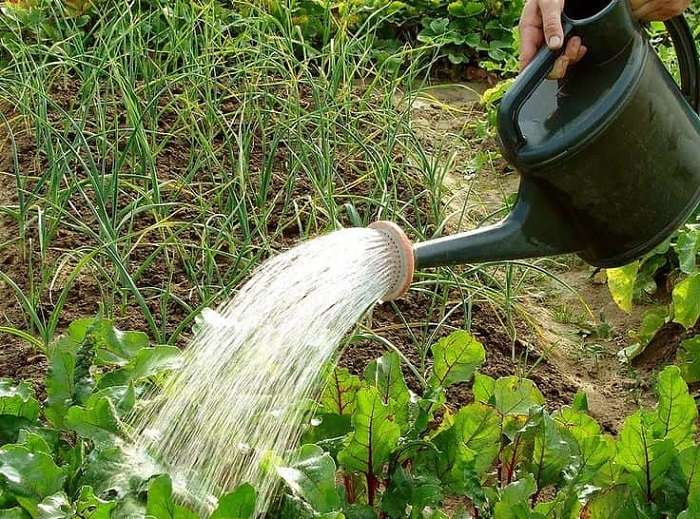

When the eyes turn black after 8-15 days, you need to re-graft the plant on the rootstock of another bush. But with an insufficient amount of juice in the trunk, the vaccination is carried out the next year.
For the winter, a rose on a rosehip bush is well spud to a height of 25 cm and covered with spruce branches or dry foliage. In the spring they clean everything, remove the harness and remove the wild growth. The rosehip is cut 0.5-1 cm higher than the grafted and living kidney and the cut is covered with pitch. The soil is fertilized in the near-trunk circle with mineral fertilizers: nitrogen, potassium and phosphorus - for 1 m2 - 30-50 g. The same preparations are applied for feeding every 10 days throughout the summer.
When up to 3-4 leaves appear on the shoot, pinch its top, do the same on all new shoots, which leads to the awakening of dormant buds and stimulation of growth. The buds are removed so that food is spent on the development of shoots and the formation of a branched crown, and not on flowering. When young shoots are inclined to the ground, they are tied to a support. Roses are planted in a permanent place from grafts in the fall.
Grafting roses from a bouquet
If the bouquet consists of rare but domestic varieties of roses, then there will be no big problems in the grafting process, work can be done with foreign varieties of plants, but there will be more problems.
The rose should stand in the vase for 4 days, but no more. Several short cuttings with 2-3 buds are made from the stem, after removing the thorns. Cuttings from the bottom are split with a knife by 1 cm and put on polchal in a growth stimulator. Then they are planted in organic soil, in pots or boxes and kept at home. In early spring, after the heat stabilizes and the soil warms up, the rooted plants are planted in open ground. You can also graft roses from a bouquet by budding on rose bushes that already exist in the garden.
> When and how to plant a rose correctly
Features of grafting rose hips on rose hips
A different method is used to graft branches. The stalk and branch of the scion are cut obliquely at the same angle. Next, the cut off the stalk is tightly pressed with the cut to the stem, where the part was also cut off earlier, and tightly wrapped with strapping material.This method is perfect for grafting rose hips to rose hips. This method can be used to plant homemade roses and even flowers from a bouquet.


Why roses are reborn into rose hips
Florists are often interested in the question of why a rose, as it grows and develops, becomes a rosehip. The reason for this may be the incompetence of the gardener or the producers of the planting material. Some seedlings retain rosehip buds located slightly below the budding site. When the plant forms a root system in a new place, shoots will form from these buds, which will begin to intensively absorb nutrients. Cultivated shoots will become nutritionally deficient and may dry out.
The rose also starts to run wild because of the illiterate choice of rootstock. Some varieties of rose hips are characterized by aggressive growth and accelerated rates of development. According to these indicators, they are ahead of cultivated plants. The overgrowth that forms from the roots of such rootstocks drowns out the growth of the grafted rose.
A rose can become a rose hip as a result of mistakes made during planting. If the grafting site was not buried in the ground, the scion will quickly begin to weaken and give way to a more unpretentious and vigorous rosehip. If the plant did not huddle or cover before the beginning of winter, this can also cause its gradual degeneration into a rose hip.
Outdoor cultivation and care
Roses are planted in spring, but the period is adjusted depending on the weather conditions of the climatic zone. In warm areas, flowers can be planted in March, and in cold areas only in May.
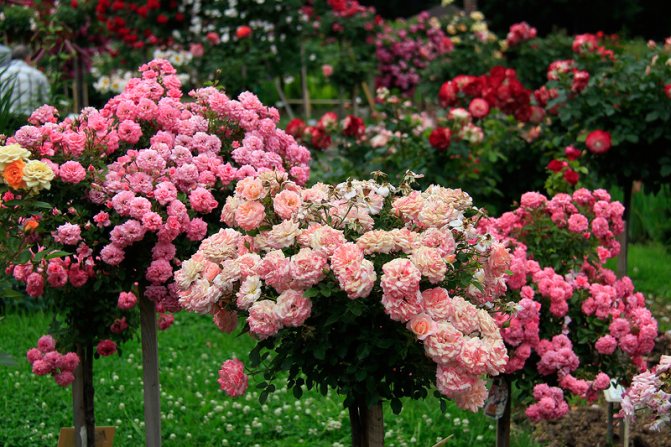

Standard roses: planting and care
When choosing seedlings, the main criterion should be its root system. It is usually distinguished by its long life, resistance to winter, various pests and diseases. Due to the fact that the species does not tolerate moisture loss, it is better to choose seedlings in pots.
Important! The best place for standard roses would be areas with good lighting and light loam. Also, the flower bed should be away from those places where the water table is high.
At first glance, it may seem that caring for such a rose can be difficult, but it is not. If you follow the advice of experienced gardeners, then planting and growing will not bring much trouble.
It is important to pay close attention to the following recommendations:
- It is better to mulch the land around the bush with manure (ripe) or sawdust. This will protect the soil from excess and loss of moisture.
- Frequency of watering should be observed. It must be carried out in the holes near the trunk.
- It is necessary to loosen the soil periodically, while trying not to harm the root system, which is located close to the surface.
- In the spring, the plants are pruned. When pruned at the right time, the bush heals, a beautiful compact crown is formed, the shoots are strengthened, and the flowering becomes even more abundant. The procedure is performed with a well-sharpened secateurs 5 mm above the already developed buds. Sections are treated with garden pitch.
- The stems are very thin and can break under the pressure of flowers and branches, so they need to be tied up.
- In order not to damage the trunks, you need to cover them from the weather with extreme caution: the trunk should first be dug in and bent to the ground, laying it on the spruce branches. Then the crown of the bush is covered with a layer of spruce branches, and on top with a film. Sprinkle soil over the base of the bush and roots. Under such a shelter, roses are kept until the cold weather passes.
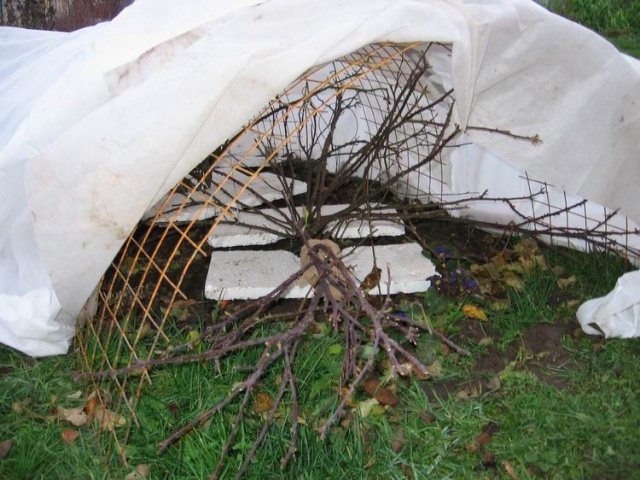

Shelter of standard roses
What do you need to have for vaccination?
- stock (rosehip, on which the rose will be grafted);
- scion (stalk of the middle part of the stem of a rose with a bud);
- sharpened knife;
- plastic wrap for strapping;
- secateurs;
- rag.
[collapse]
Terms of vaccination
As for the timing of vaccination, then spring is considered the best period... Leaves and young shoots appear on the bushes. It is important that new stems do not have time to start growing. The plant should not be disturbed during the dormant period of the buds.
Vaccinated in summer... In the stems there is an active movement of the juice, which contributes to the rapid engraftment of cuttings of roses. The new shoots have already bloomed and can be used as a scion. The robot begins to spend in the month of July or August.
Rose grafting is also used in winter - in February... This method is more time consuming and less popular. The cuttings do not take root well, and the work is rather difficult.
A new rose on an old rose hip, or another "old-fashioned" way of grafting
Inoculation in the root collar is the best method of grafting, which is characterized by 90% survival rate and easy care. And already from grafted cuttings (this spring) next year in the fall it will be possible to get small independent plants. Those that, in a few years, will amaze with abundant flowering!
And now - an accurate and complete instruction for grafting a rose on a rose hip. This is a rule-of-thumb exercise in order for you to be happy with the result. Start by being in a good mood, having enough free time, and making sure you have the right tools. So that at the most crucial moment you have a grafting knife, a pruner, a plastic wrap, an adhesive tape, and a shovel at hand.
Scion preparation
Process steps:
- Preparation of the scion, which consists in cutting from previously selected, strong and healthy, cuttings of roses of the buds of the scion together with a shield (the length of the latter is 2 cm).
- Stock preparation: it is necessary to select rosehip bushes, to clean the neck of the bush from weeds and soil, wipe off the ground with a damp cloth.
- Make a T-cut on the north side of the neck of the bush. This will provide maximum protection from wind and sun rays, which will facilitate early survival.
- Insert the prepared scion into the T-shaped incision, gently bending back the bark. Close the upper and lower parts of the stock with foil, press (but do not press) tightly, wrap with tape or rag.
- Cover the grafted kidney with moist soil.
Attention! Many amateur gardeners keep the cuttings of the rose, from which they will cut the buds for the scion, in special rooting formulations. So the cutting stores the necessary nutrients, micro-, macro-elements, and it has more chances to take root in a "new place".
The rose has been grafted onto the rose hips, but it is too early to talk about the results. Ahead is the painstaking work of scion care, on which the final result depends!
The vaccine must be protected from wind and cold.
Choosing a vaccination site
For grafting, you can choose any rose or rosehip bush available on the site. As the practice of gardeners shows, grafting with eyes takes root better than cuttings. The peephole itself can be revived anywhere - both on the stem and directly to the root collar. But if the method of grafting into the split is chosen, it is important that the rootstock and the scion are of the same thickness, and the bush itself, on which the grafting will be performed, must be cut low.
Video: How to plant a rose on a rosehip
How to choose a stock
More often, a rose is grafted onto a rosehip, especially a too whimsical one. Rosehip (Canina rose or dog rose), although a relative of the rose, is wild, it does not require the same care as the rose. Its root system is well developed and has already adapted to the quality of the soil and the cold climate.
Important. Used for budding a 3-year-old rosehip stock, grown by dividing the root, and not from cuttings.
On the rose hip bush, the root collar should be well developed, for example, up to 10 mm thick. The bark (top layer) should be ripe, light and well exfoliated from the wood. Earth is removed from the dug rose hips and the root part is wiped. Then, on the neck of the bush, double oblique cuts are made under the tongue.


A rootstock of frost-resistant rose species with a root system must be compatible with the scion, i.e. with the intensity of growth of shoots that are grafted.It is important to know: is the rootstock capable of producing wild growth, how resistant it is to pests and diseases, how long the growing season lasts, how it reacts to drought and excessive moisture. For example, the wrinkled rose as a rootstock is popular for propagation of standard plants, but it produces many wild shoots. Strong plants will grow on a multi-flowered rose, but they will be short-lived.
Grafting a rose on another rose has its own characteristics and disadvantages, and rootstock varieties have their own characteristics:
- Multiflora is a winter-hardy, vigorous rootstock variety with 75% eyepiece survival rate. It can winter under snow up to - 45 ° С, without snow - up to - 30 ° С, lives for 22-25 years and does not give wild growth. It is recommended to plant Floribundas on this type of rose. They are well preserved during shipment, take root, actively bloom, form many buds. Flowers retain the size of the bud, bright original color by 15-30% of the standard, maximum doubleness.
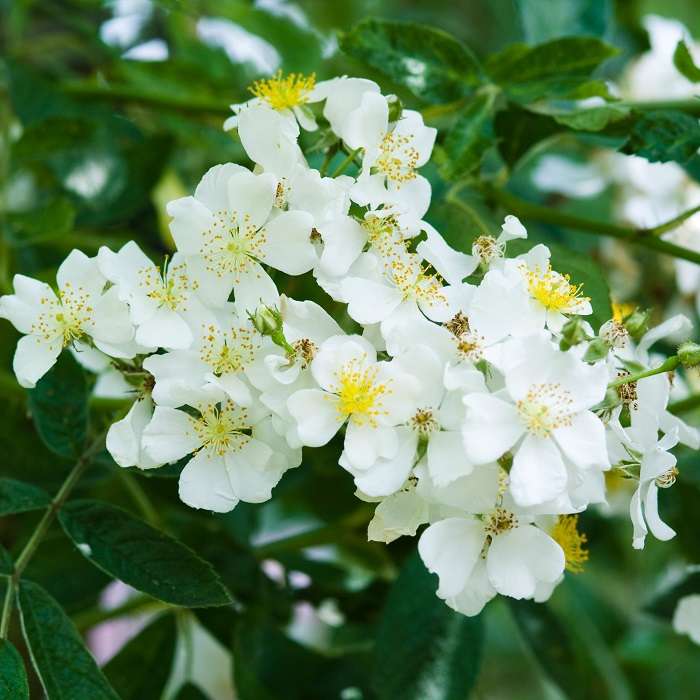

Disadvantage: on alkaline soils prone to chlorosis, low resistance to powdery mildew and spotting.
- Canina - refers to a winter-hardy rootstock variety. Grown on soils: medium and slightly alkaline. Suitable for hybrid tea roses due to the slow development of the scion and long life. The flowers will be 20% lighter than standard, with maximum doubleness. Moderate flowering will not reduce the number of inflorescences compared to the original plant.


Disadvantage: Budding can be carried out only in a limited period due to unstable sap flow. Rust, powdery mildew or black spot may appear on the new plant.
- Kukolinsky is an excellent rootstock for any rose due to its good survival rate. The color, number and size of inflorescences of the new plant will correspond to the original.
Disadvantage: Due to poor resistance, rust often has to be dealt with.
- Senff's Canina is a strong and hardy plant. It is used as a rootstock due to its developed root system. A new shoot develops and grows as standard.
Disadvantage: wild shoots of old plants grow abundantly, can suppress newly grafted buds.
Garden equipment for grafting
Grafting a rose on a rosehip or on a rose is not complete without professional garden tools:
- grafting secateurs with two blades: omega-shaped and V-shaped;
- an eyepiece knife with a concave-convex blade and a sharp end, as well as a protrusion at the base to push the bark of the rootstock;
- copulating knife with a straight blade for grafting cuttings. It is convenient for long and even cuts;
- garden shears with comfortable rubberized grips;
- strapping material: bast bast, electrical tape, PVC or polyethylene film, elastic, durable and resistant to moisture and UV rubber strips;
- comfortable and tear-resistant rubber patches for budding. They protect the grafted kidney and promote its growth, as well as the development of a new shoot;
- labels for cuttings so as not to confuse them. Suitable for labels, cardboard pasted over with tape or pieces of plastic cup;
- permanent marker for writing on labels;
- means for putty wounds: garden varnish, so as not to get an infection.
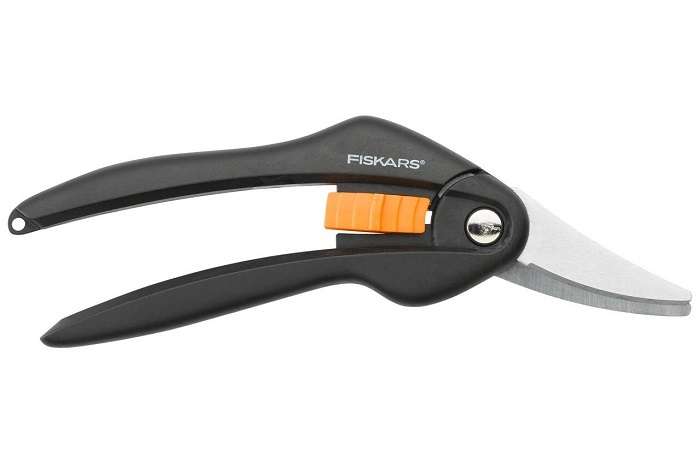

You can make your own garden putty using the following recipes:
- For var you need paraffin (6 parts), rosin (3 parts), vegetable oil (2 parts). After the paraffin is melted, rosin is added and everything is brought to a boil, oil is gradually introduced and kept on fire for up to 10 minutes. Allow the mixture to cool down and then knead it and place it in a glass container with a lid. To use the var, you need to put the jar in a "bath" in hot water.
- For a cold-liquid garden putty, you will need: rosin - 140 g, wax - 150 g, mutton fat - 100 g and alcohol - 50 ml. The alcohol is poured in only after the three ingredients have been melted and then cooled down. Store the putty in a bottle and do not heat before use.
- For solid garden putty you will need: resin - 400 g, alcohol - 50 ml and linseed oil - 25 ml. The resin is melted, cooled and alcohol and oil are poured into it, kneading it well with your hands. Also knead before use.
It's important to know. For good wound healing, 1 tablet of Heteroauxin is added to the garden pitch (1 kg). If there is no garden varnish, wax, oil paint, mullein mixed with clay in equal parts by weight may come in handy.
Tools and strapping material


Vaccination is an operation and it requires not only the skillful hands of a gardener, but also high-quality garden tools. To work with the material (scion, stock), you can use the following tools:
- grafting secateurs;
- budding knife;
- gardening scissors.
The grafting pruner has replaceable knives, facilitates the execution of cuts of the same size on scions and rootstocks. Good quality cuts guarantee a good result. Cut the cuttings with garden shears. Convenient to use models made of high-strength steel, small size, with rubberized handles.
Purpose of the budding knife: make even T-shaped cuts, cut off the flap. There is a special knuckle on the blade to separate the bark from the wood. The point is sharpened on one side, the sharpening angle is sharp. The quality of the steel from which the blade is made and its thickness are important, it should not exceed 2 mm. To sharpen the blade, you need a coarse block and goi polishing paste.
On a note. The result of the vaccination depends not only on the quality of the instruments, but also on its purity.
The strapping material can be made by yourself or purchased at a specialized store. Usually, they simply cut the tape to the desired width from a suitable material:
- plastic film;
- medical oilcloth;
- electrical tape.
When budding, the width of the tape is 15 mm, the width of the binding for fixing the handle is 25 mm.
The method of grafting roses into the "split".
This method is somewhat similar to the previous one. Its essence lies in the fact that the stock is cut horizontally, and a split is made in the middle of it to a depth of 1-2 cm.
The graft is cut horizontally with a sharp tool, and a split ledge is made vertically in the middle (up to 3 cm). Before this, one or two cuttings with 1 - 3 buds are prepared, which will personify the function of the wedge: they are inserted into the split, one side of which starts above the kidney, and the other from the opposite part. Cut obliquely over the upper bud. Then the scion is inserted into the stock. See as in the photo above.
The wedge of the cutting should be slightly longer in comparison with the depth of the rosehip trunk window when grafting roses into the "split".
A small window after insertion of the scion into the stock will promote better callus formation.
Remember that roses smell quite strong, so don't plant them too close to your home or patio if you don't like their scent. And accordingly, on the contrary, if this smell gives you pleasure, plant roses where they will delight you especially.
Typical mistakes
Due to inexperience, many gardeners make mistakes that ruin all their endeavors. We give you a list of the most common mistakes:
- Vaccination is carried out in rainy weather. If even a drop of moisture gets into the incision, engraftment does not occur;
- Still immature buds were selected for budding. As already mentioned, the best buds for grafting are those growing on the middle part of the shoot. But even this is not a guarantor. Before you start cutting, you need to make sure that the bud is ripe, dense in structure, has no visible damage and is cut from a healthy shoot;
- The material was taken from bushes infected with pests or fungal diseases. Such a scion does not take root. But even if this happens, the scion will be infected. And the vaccine still dies in the future.
What is required for the procedure
First of all, of course, healthy material and skillful hands of a gardener.But if everything is clear with the material, then whether the hands of the grower are even golden, they will not do without high-quality tools. It is recommended to have with you:
- grafting secateurs - cuttings are cut with them;
- bud cutter;
- garden shears for cutting the strapping material.
We sharpen the toolkit well. The harness can be purchased ready-made, or you can do it yourself (many do so). To do this, tapes with a width of about 15 mm are cut from any suitable material (for budding). For tying cuttings, the tape will need to be slightly wider - 25 mm.
Now read:
- Choosing cucumbers for open ground according to your preferences
- Description of 12 types of late varieties of cabbage for planting
- Planting to decorate the site with three types of conifers
- Exquisite junkus (sitnik) spiral in the interior
About
Agronomist of the state agricultural enterprise "Garovskoye" of the Khabarovsk region of the Khabarovsk region.
Application in landscape design
In the design of gardens and lawns, there are quite a few opportunities for using standard roses. These can be stairs, walls, vertical supports, and flower beds, flower beds, robots and recreation areas.
Advice! Combining standard and ordinary flowers, you can create multi-tiered compositions, effectively beating the space.
- Rose trees can be planted like soloists in the center of the lawn, and small ground cover plants can be used around.
- The effect of a waterfall of flowers can be achieved by planting weeping forms of standard roses.
- For a large garden, it is possible to create an entire alley of rose trees.
Even a beginner can grow beautiful standard roses in their garden, following the recommendations of more experienced gardeners. These lush trees will adorn gardens for years with the right care. Standard roses, planting and caring for which in the open field require certain knowledge - it is not difficult if you master the process of creating this type of bushes. There are many options for combining other plants, thanks to which you can create a fabulous atmosphere in the garden and become the creator of these wonderful flowers on a thin leg.
Rose on the trunk
Plant grafting options
Consider spring grafting as the most popular among gardeners. All work begins in the middle of the first spring month.
There are two ways:
- copulation (splicing of rootstock and scion). The method is called cleavage;
- budding - kidney grafting. The method is called peephole propagation.
The first method is used only on those shoots that are already lignified. Ask why young shoots are not used? Their inner tissue is too soft and does not promote fusion. As a percentage, this is expressed approximately 50 × 50.
Into cleavage (copulation)
On the dog rose, you need to make a longitudinal incision, in the root part of the trunk. The bark at the incision site is pushed back. A prepared scion stalk is inserted into it. It is prepared by the following method - it is cut obliquely below the kidney, a two-centimeter cut. Above the cut, it is required to make an incision across the trunk with a small depression (1-2 mm). The latter is done in the form of a ledge.
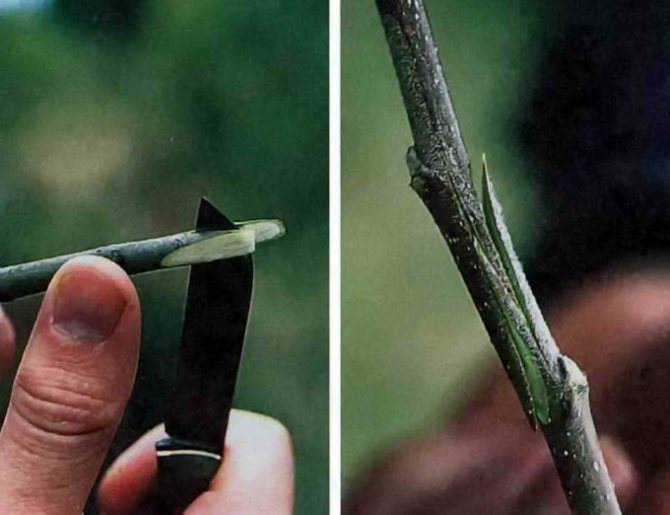

The junction is required to be tied with any suitable material. To avoid confusion between the bottom and top, the upper part of the scion is cut obliquely.
After the procedure, the bushes are placed in some kind of container. If you have prepared a lot of material, then in the container they need to be shifted with moss (sawdust). Remember to keep the bed wet. Sometimes, due to moisture, mold appears in it; a little crushed charcoal will help to avoid this.
We put the box with the prepared cuttings in a cool place where the temperature does not rise above 15 degrees. It is necessary to create such conditions under which the cuttings will be surrounded by high humidity with a constant temperature. Only in this way a build-up quickly forms at the site of vaccination. In agricultural technology, it is called "callus", which means corn. It is he who is reminiscent of the formed growth.
The temperature should be constant and not fall below plus 10, otherwise the formation of a build-up is difficult. And if the temperature is above 15 degrees, then the kidneys begin to actively swell, which at that time is also not good.
About three weeks after the event, the room temperature should be raised. Existing buds stop blooming, but fusion will continue. After all, it is a rather lengthy process in itself.
Complete connection of the rootstock and the scion occurs no earlier than one and a half to two months after the operation. We remove the bandages from the cuttings and plant the bushes in the garden. It is necessary to cover the plantings with a film - this is necessary to protect the kidneys from drying out.
The bushes are shrouded in earth. Gathering it around the trunk in the form of a mound, which needs to be lightly tamped. As new shoots appear, the soil is gradually raked away from the tree. This is done either in the evening, after sunset, or in cloudy weather. This will avoid sunburn, because new sprouts are still weak and need a couple of days to grow stronger.
Popular: Perennial miscanthus cereal for decoration in landscape design
Bush formation
As soon as you consider that there are enough new shoots, you can start forming a bush. To do this, cut off the top of the bush. Thus, its further development is suspended and initiates the appearance of additional lateral shoots.
It is the latter that must be protected, since it is they who are intended for flowering. If the central shoot continues to grow after pruning, then it must be re-pinned. This is done in the area of 5-6 leaves. If you did everything correctly, then three to five young shoots are formed around it, located symmetrically.
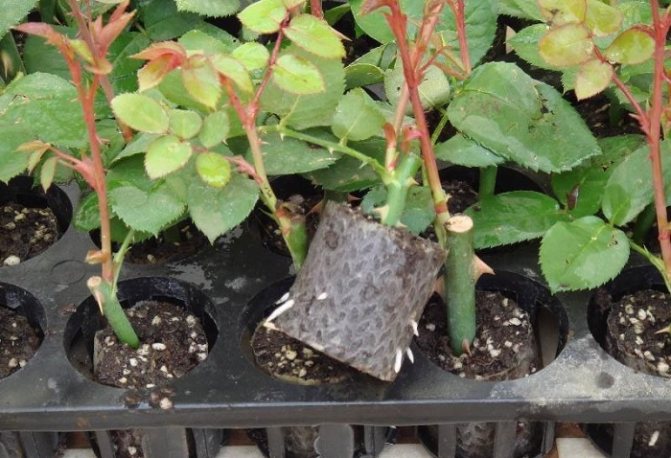

T-shaped or budding secrets
The procedure is a little more complicated. Here we use a special budding knife, it is with it that the eye is cut from the rose. It can be cut with or without wood. This is done like this - count from the kidney about 8 mm. up and slice down. Leave a piece up to 12 mm under the kidney. length. As a result, you get a cut of wood with a total length of up to 30-40 mm.
The cut should not be too thick. For correct budding, experience is required, so gardeners suggest first practicing on other less valuable plants, on the same rose hips. Not to spoil expensive rose bushes. Ideally, you should have on your hands a pink bud on bark (wood) 3-4 cm long, without visible damage.
A cross-section of the bark is made on the rose hip in the form of the letter "T", the edges of the cut are bent to the sides and the cut kidney is inserted into it. This procedure is more inherent in the summer vaccination. Also, the junction is tied with improvised materials.


Many gardeners ask: how do you know if a kidney is ready for vaccination? The selection is carried out from a bush that has already faded from its middle part. And readiness is determined simply - by the thorns. You need to try to break them off - if they break off easily and without bark, then that's it, the kidney can be cut off.
Scion preparation
The rose bush, from which the stock will be cut, is watered vigorously for several days so that there is a good separation of the skin from the core. An annual shoot is selected that meets the following conditions:
- the flower on it should already bloom and crumble;
- the stem is selected even, with a thickness of about 6 mm;
- there are formed buds in the shoot axils, but they should not grow yet.
Cuttings are harvested immediately before budding, if this is not possible, then they are stored in the refrigerator, wrapped in a damp film
The stem is freed from thorns, a third of the petiole is left at the leaves, then the bud is cut off. The lower one is considered the strongest, but you can take several. The dormant kidney cut and prepared for inoculation is called the scutellum.
The shield is cut off with a clean, sharp knife (there are special tools for budding). In this case, a thin layer of wood is captured.The total length of the scutellum is 2 cm: 0.8 cm above the kidney and 1.2 cm below. Then the woody part is removed.
Several shields were cut from this cut of the rose for grafting.
The preparation of the shield is carried out immediately before inoculation.
Video: preparing a rose grafting shield
Competent care of rose hips, or the future of a rose bush
Cutting cuttings, finding a stock and planting a few buds on a new plant is only half the battle. The second is to provide the best conditions for the survival of the scion. If everything goes right, then by the fall the rose on the rose hips will form its own shoots. And next spring it will already be possible to begin the formation of the future rose bush.
In the meantime, only the work of caring for the neck of the rosehip bush. In the first days after vaccination, you must not forget about:
- constant soil moisture. Water will not only contribute to better nutrition of the plant, delivering useful substances, but will also be able to promote rapid engraftment, easy and simple;
- the purity of the earth. Weeds should not be allowed to overgrow the place at the neck of the bush, because weeding can damage the graft and the rose will not take root. You will have to start all over again;
Rose sprouts
- loose soil, through which water and oxygen will easily flow, enriching the stock and helping to develop correctly.
With the correct procedure, the rose on the rose hips will sprout in the fall. You don't need to do anything with them, all that remains is to wrap the bush, protecting it from frost, and wait until spring.
In the spring of next year, when it gets completely warmer, it is worth digging out the neck of the bush and freeing the bud, which has turned into an escape, from the plastic wrap. Prune the rose hips, and also begin the formation of the future rose bush. In the fall of this year, you can transplant the rose to its permanent place. Rejoicing in success, think again about grafting the variety!
Roses are wonderful flowers, decorations for any garden. It so happens that the neighbors like the variety of the rose, but it is not always possible to grow it with cuttings, so many use a rosehip graft.


